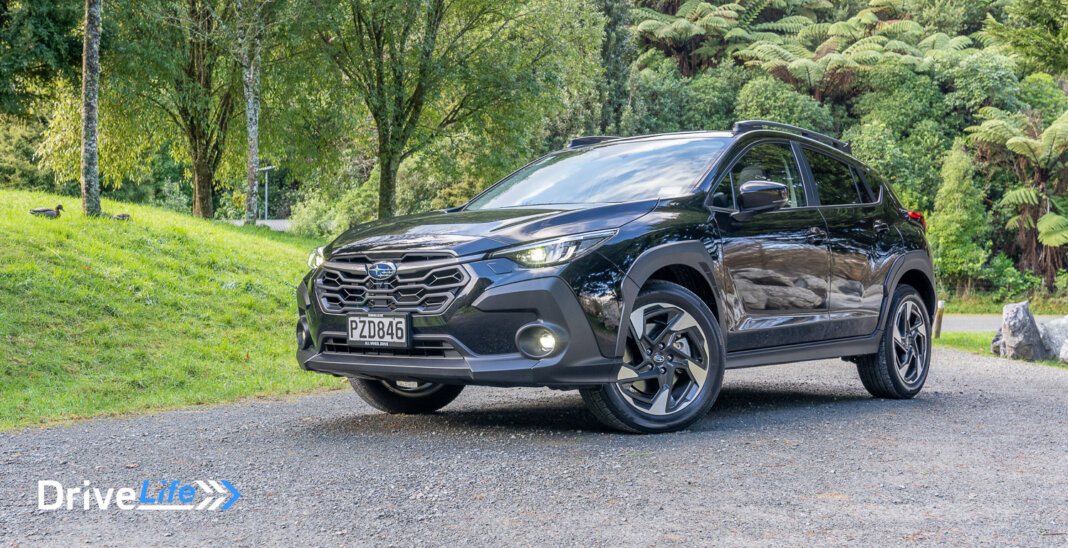You’ve probably seen the extremely catchy TV adverts for the Subaru Crosstrek, where the tagline is “Have it all-wheel drive”. A great play on words, along with other catchy phrases like “Off-course degustation”, “Million-star reviews”, and “Valley Parking”. Very witty stuff.
Every single shot in that advertisement purposely shows the Crosstrek offroad but if we’re being honest, most Crosstreks will spend their life on the tar seal with an occasional drive on a metal road, into a farmer’s field – or more likely, up the mountain for a weekend’s skiing.
The Crosstrek is the new name for the Subaru XV, a very popular car in New Zealand with lots of die-hard owners who absolutely love them. We went to the launch of the car earlier this year and found it to be similar to the XV, with a few tweaks here and there.
So – what’s it like to live with the Crosstrek as a Daily Driver for two weeks? Our testing will include a 600km weekend’s drive to work on our project car, ensuring we get some decent miles on the Crosstrek so we can give a proper verdict on it.
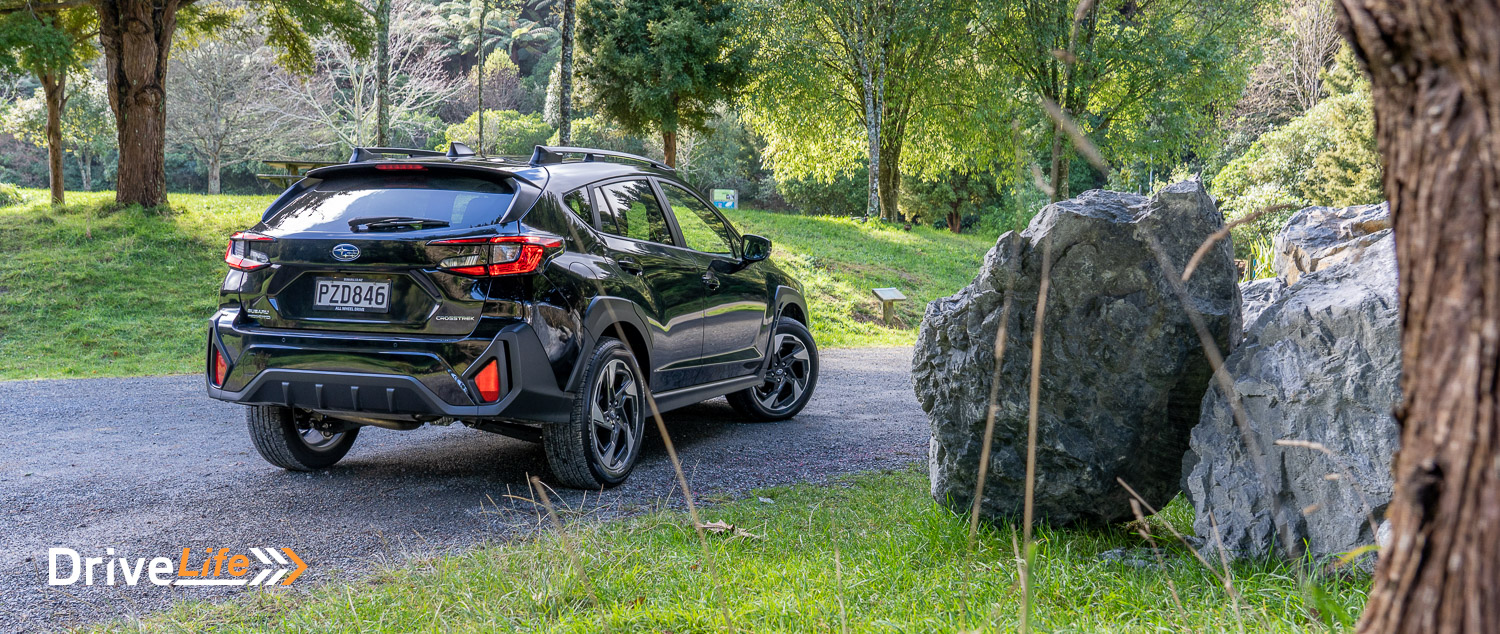
What We Like and Dislike About The 2023 Subaru Crosstrek Premium
| What we like | What we don’t like |
| Easy to live with every day Practicality Surety of all-wheel drive Speed Limiter functionality Directional headlights Relative fuel economy Equipment levels Centre display resolution and operation Less beeping Ride quality Improved CVT transmission Seat comfort | Engine can be noisy Driver Monitoring System too keen Can feel underpowered at times |
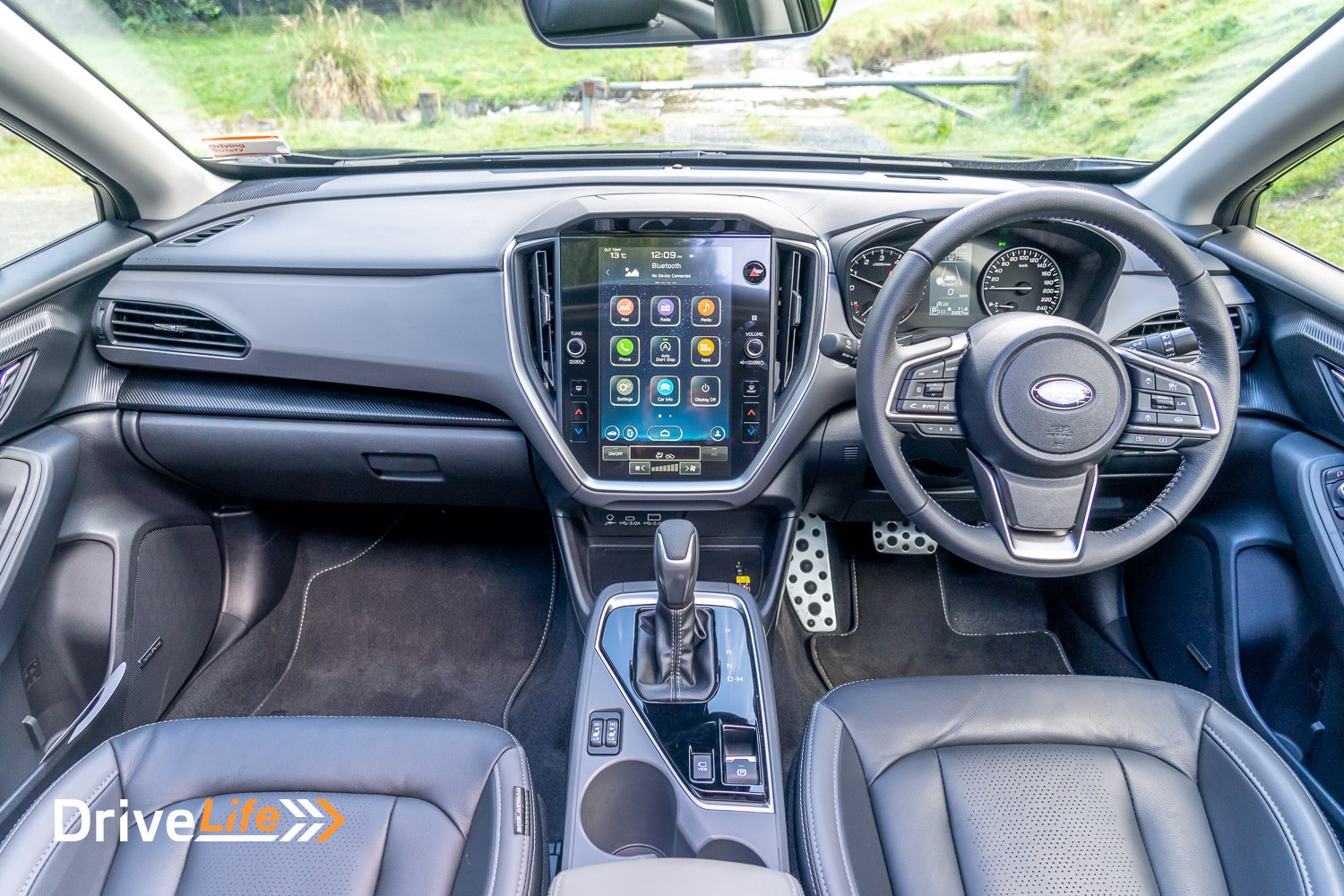
What’s In The 2023 Subaru Crosstrek Range?
There are three models of Crosstrek available in New Zealand:
- Crosstrek Hybrid – $46,990
- Crosstrek Premium – $48,900 (tested)
- Crosstrek Premium e-Boxer Hybrid – $51,990
While all three models run the same 2.0-litre, 4-cylinder petrol motor, the non-hybrid Premium model has a power output of 115kW while the Hybrids are 110kW. Torque for the petrol engine in all models is 196Nm.
All Crosstrek models require 95-octane fuel, with fuel consumption for the hybrids listed at 6.5L/100km while the non-hybrid is 7.2L/100km. Hybrid models are assisted with a 12.3kW electric motor, adding 66Nm of torque to the total output.
The non-hybrid has an 8-speed Linetronic automatic transmission while the hybrid models have a 7-speed Linetronic automatic transmission. While both are constantly variable transmissions (CVT), Subaru has them with a stepped mode, effectively giving them gears to use when needed.
All Crosstrek models use Subaru’s Symmetrical All-Wheel Drive system.
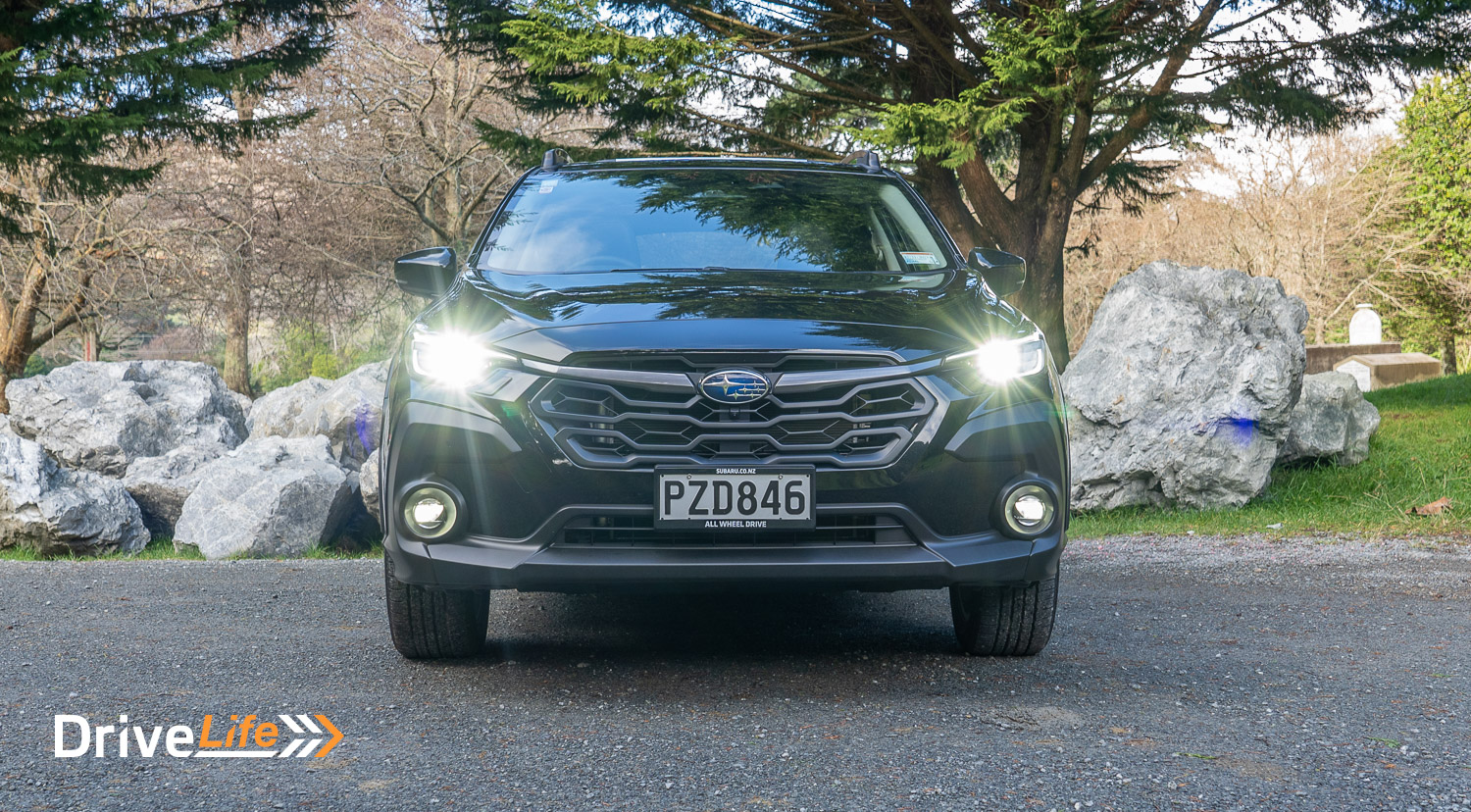
2023 Subaru Crosstrek Standard Equipment Highlights
Safety Features as standard include:
- Autonomous Emergency Steering
- Distraction Warning
- Drowsiness Warning
- Automatic Stop-Start
- Adaptive Cruise Control
- Lane Departure Warning
- Lane Sway Warning
- Lead Vehicle Start Alert
- Pre-Collision Brake Assist
- Pre-Collision Braking System
- Pre-Collision Throttle Management
- Facial Recognition
- Lane Centering Function
- Lane Keep Assist
- Speed Sign Recognition
- Tyre Pressure Monitoring System
Other Features Include:
- 17″ Alloy Wheels
- Door Mirrors With Indicators – Power Folding
- Daytime running lights
- Fog lights
- Automatic headlights
- Dual-zone AC
- Automatic wipers
- Keyless entry and start
- 11.6” centre touchscreen
- Qi wireless phone charging
- Wireless Apple CarPlay and Android Auto
Moving up to either of the Premium models adds:
- 18” alloy wheels
- LED front fog lights
- Self-levelling headlights
- Steering-responsive headlights
- Alloy pedals
- Leather seating
- 8-way power driver’s seat
- Heated front seats
- Electric lumbar adjust – driver’s seat
- SatNav
- 10-speaker audio
There are ten colours in the Crosstrek range:
- Crystal Black Silica
- Crystal White Pearl
- Horizon Blue Pearl
- Ice Silver Metallic
- Magnetite Grey Metallic
- Oasis Blue (new)
- Offshore Blue Metalic (new)
- Pure Red
- Sapphire Blue Pearl (new)
- Sun Blaze Pearl (new)
For a full list of specs and options available for the 2023 Subaru Crosstrek Premium, head on over to Subaru New Zealand’s website.
How Does The 2023 Subaru Crosstrek Premium Compare To Its Competition?
All prices below exclude the refund or additional cost of the New Zealand Clean Car Programme.
| Make/ Model | Engine | Power/ Torque kW/Nm | Seats | Fuel L/100km | Towing Capacity | Boot Space, litres | Price (excl CCP) |
| Kia Sportage X-Line 1.6T 2WD | 1.6-litre 4-cylinder turbo | 132/265 | 5 | 8.0 | 750/1,600 | 543 | $55,990 |
| Volkswagen Tiguan Style AWD | 2-litre 4-cylinder turbo | 132/320 | 5 | 9.6 | 750/2,100 | 615 | $61,990 |
| Hyundai Tucson Active | 1.6-litre 4-cylinder turbo | 132/265 | 5 | 7.7 | 750/1,600 | 620 | $57,990 |
| Seat Ateca 4FR | 2-litre 4-cylinder turbo | 140/320 | 5 | 8.0 | 750/2,000 | 485 | $54,500 |
| Skoda Karoq Style | 1.4L Turbo Petrol | 110/250 | 5 | 7.2 | 750/1,500 | 521 | $51,990 |
| Ford Escape ST-Line AWD | 2-litre 4-cylinder turbo | 183/387 | 5 | 8.6 | na/1,800 | 556 | $50,990 |
| Mazda CX-5 Activ | 2.5-litre 4 cylinder | 140/252 | 5 | 8.2 | 750/1,800 | 401 | $50,990 |
| Mitsubishi Outlander XLS 4WD | 2.5-litre 4 cylinder | 135/244 | 5 | 9.0 | 750/1,600 | 651 | $49,990 |
| Kia Sportage Deluxe AWD | 1.6-litre 4-cylinder turbo | 132/265 | 5 | 8.0 | 750/1,600 | 543 | $49,990 |
| Subaru Crosstrek Premium | 2.0-litre, 4-cylinder petrol | 115/196 | 5 | 7.2 | 650/1,400 | 291 | $48,990 |
| Toyota RAV-4 GXL AWD | 2.5-litre 4 cylinder | 152/243 | 5 | 7.0 | 750/1,500 | 542 | $45,990 |
| Honda CRV AWD Touring | 1.5-litre 4-cylinder turbo | 140/240 | 5 | 8.2 | na/1,500 | 522 | $45,000 |
| MG HS Excite | 1.5-litre 4-cylinder turbo | 119/250 | 5 | 7.3 | 750/750 | 463 | $36,990 |
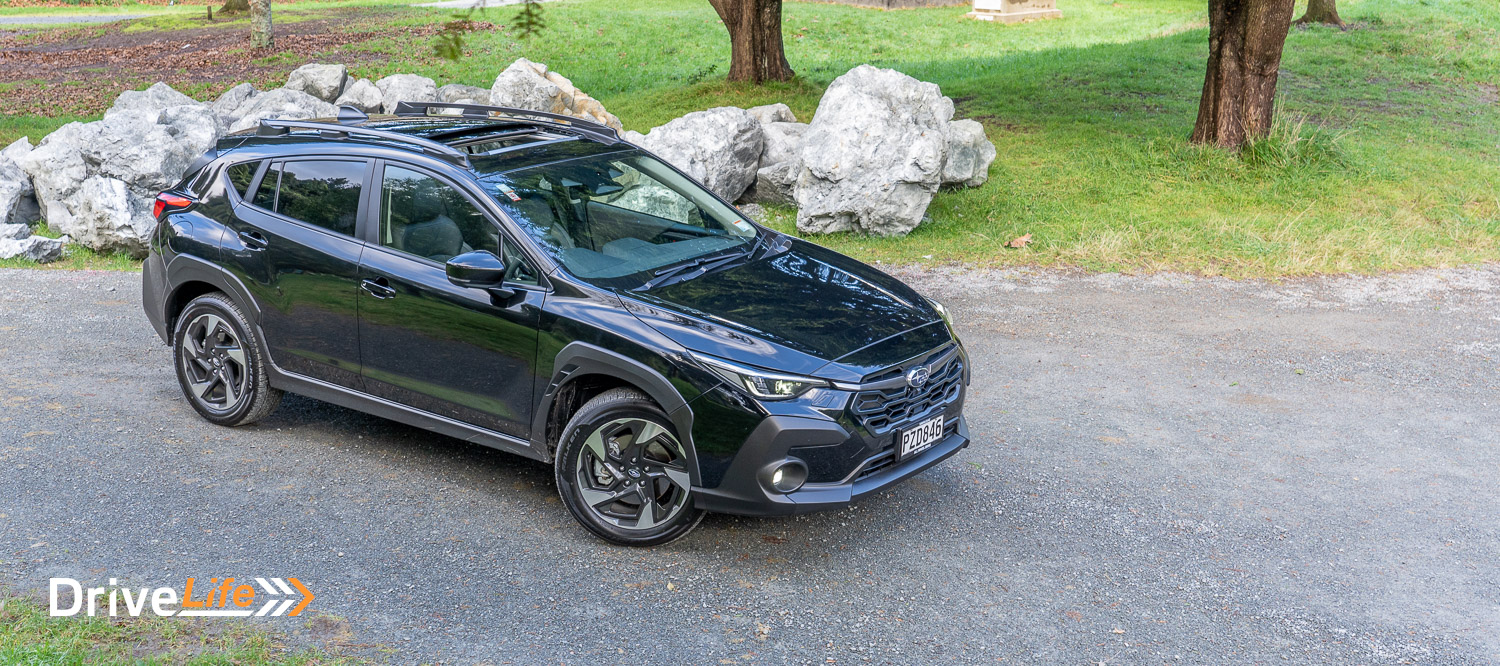
First Impressions Of The 2023 Subaru Crosstrek Premium
It doesn’t feel like there’s a huge difference in design between the Crosstrek and the XV, but once you line them up side by side, the changes are more severe with a far more modernised front, at least. The whole car is now looking like a mini Outback, and that’s no bad thing.
Side on, there are not many changes from the XV other than deeper scalloping in the doors.
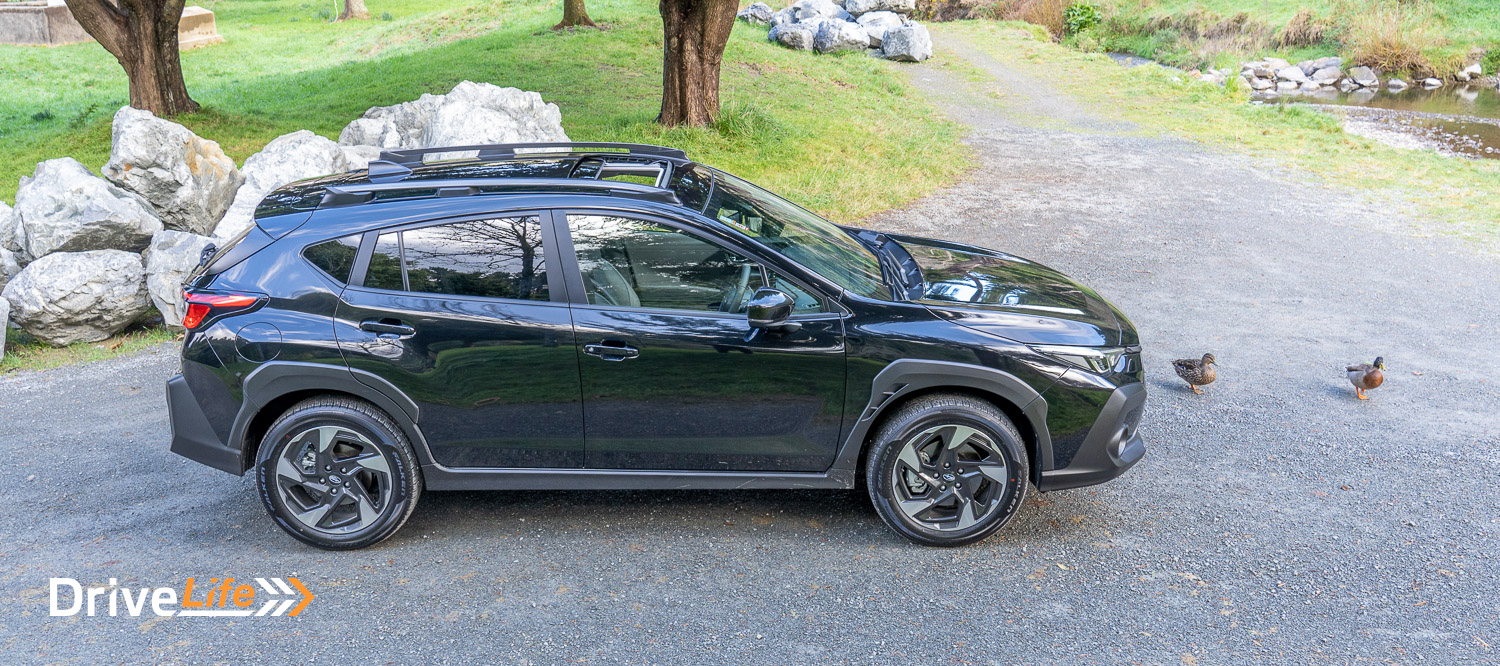
Overall, it’s more current than the XV and it’s not a bad looker either; Finished in Crystal Black Silica, our test car was sharp and crisp, standing out in the parking lot. That can be hard to achieve in 2023.
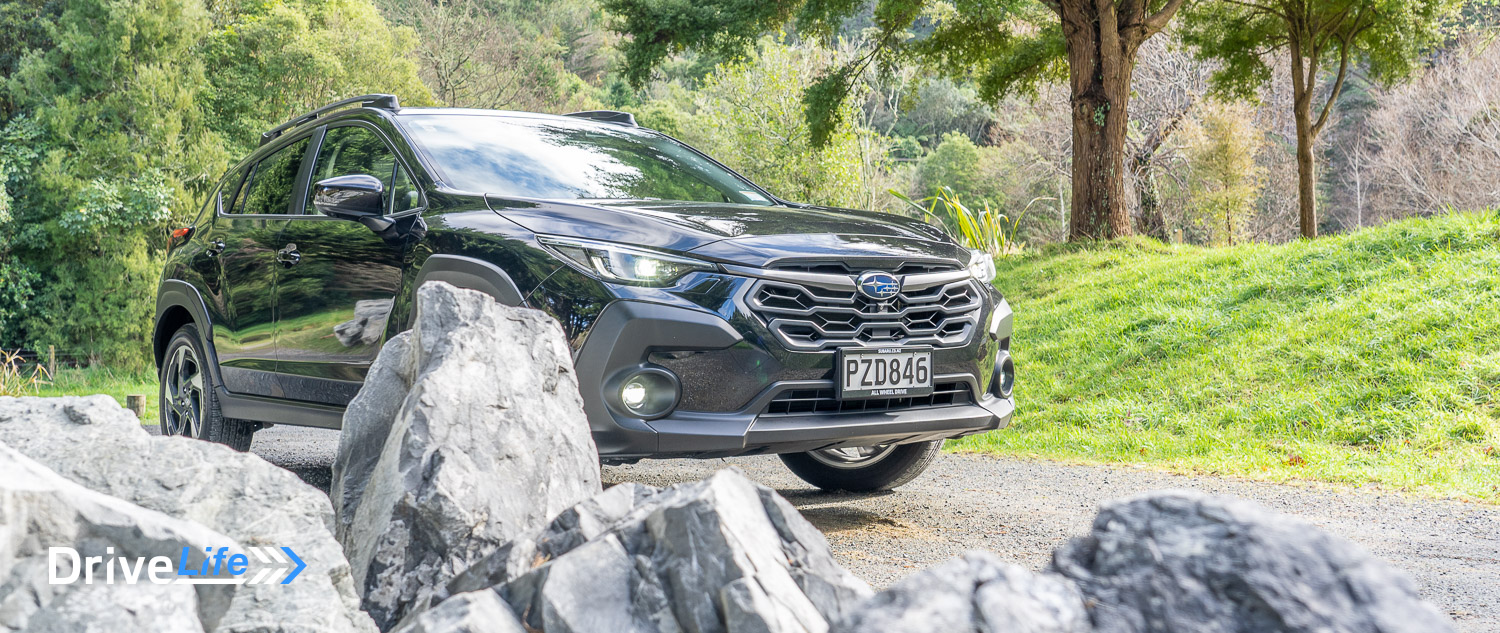
What’s The Interior Like In The 2023 Subaru Crosstrek Premium?
The thing that instantly grabs your attention is the new centre display, measuring a very usable 11.6”. It runs Subaru’s current operating system and is a doddle to use. It’s all very intuitive with little lag between screens.
On the sides of the screen, it’s excellent to see that Subaru has had the common sense to retain a volume knob on the right, and a track/station selection button on the left. Other niceties here are the physical front and rear demist buttons, and physical temperature adjust buttons for driver and passenger. It feels sad to highlight these as a feature but with so many manufacturers moving to AC adjustments only via a screen, having proper physical controls for these is a definite plus.
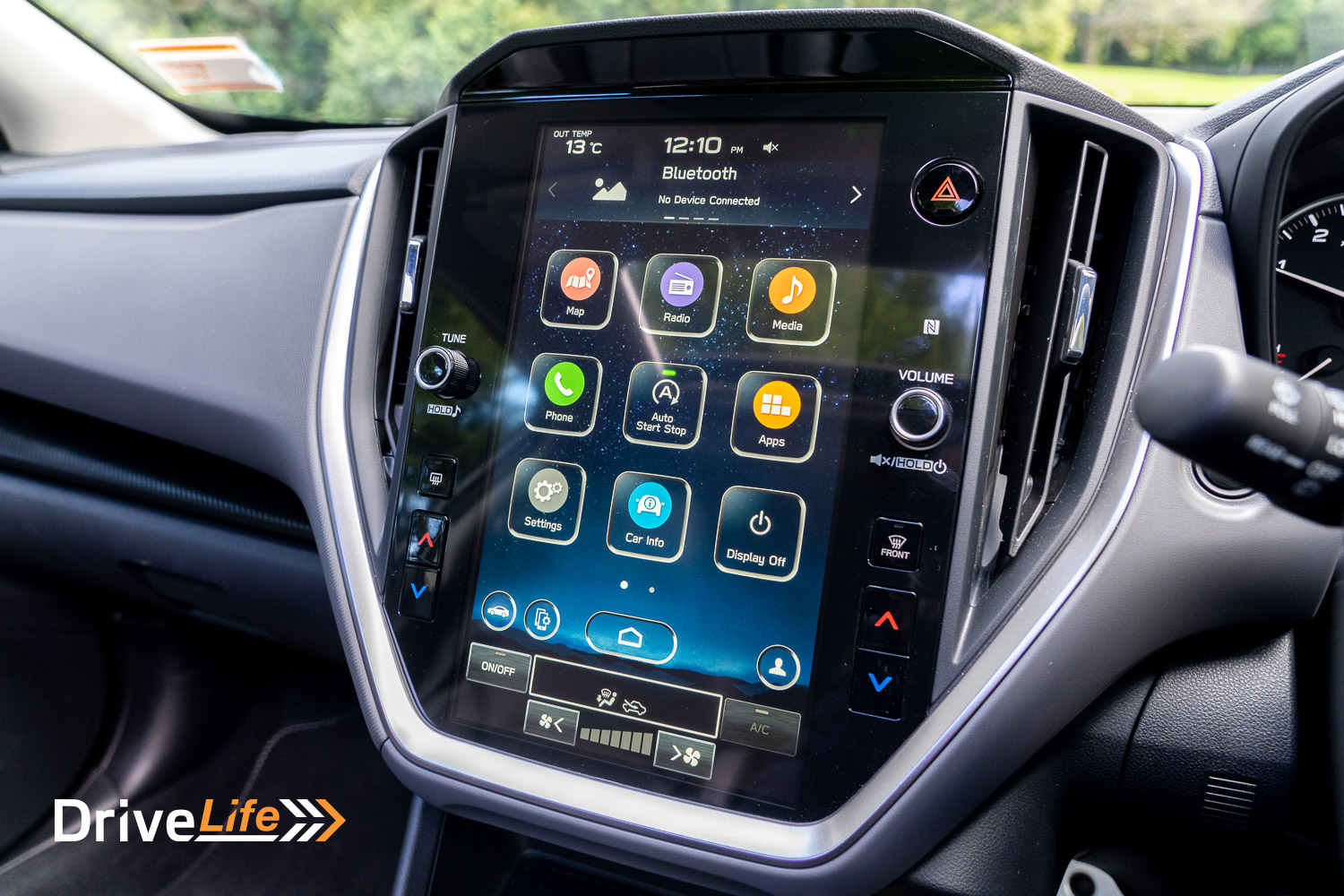
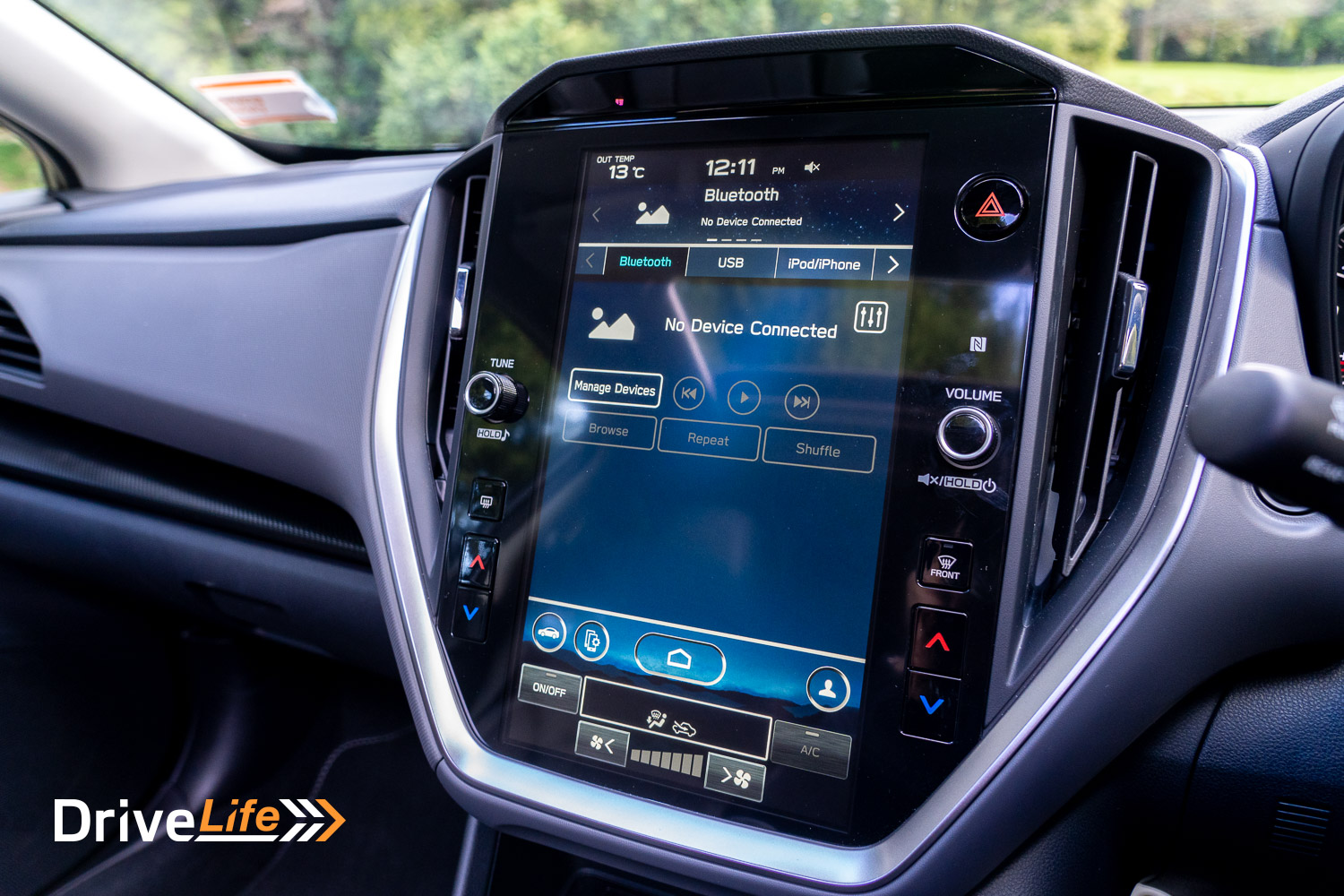
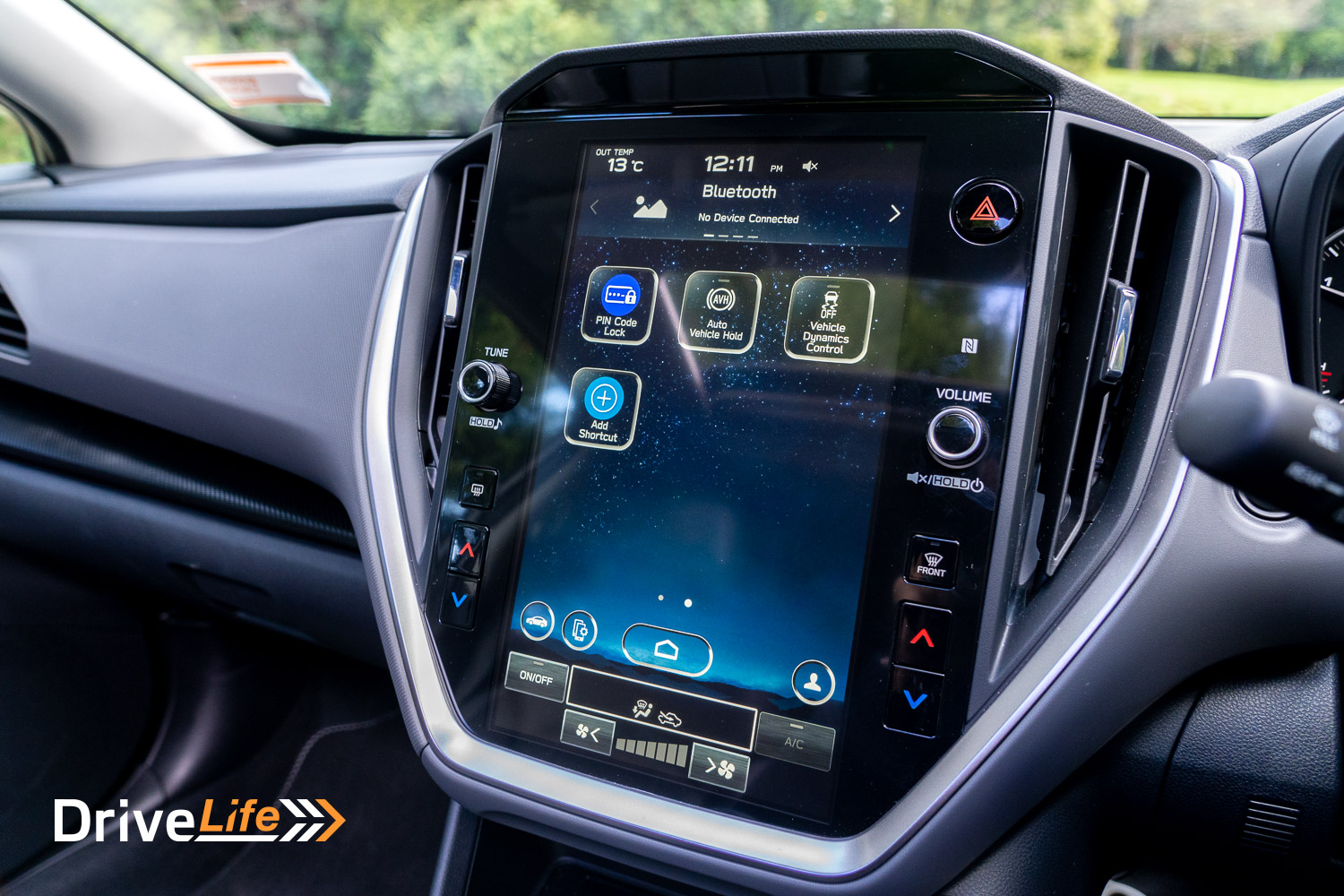
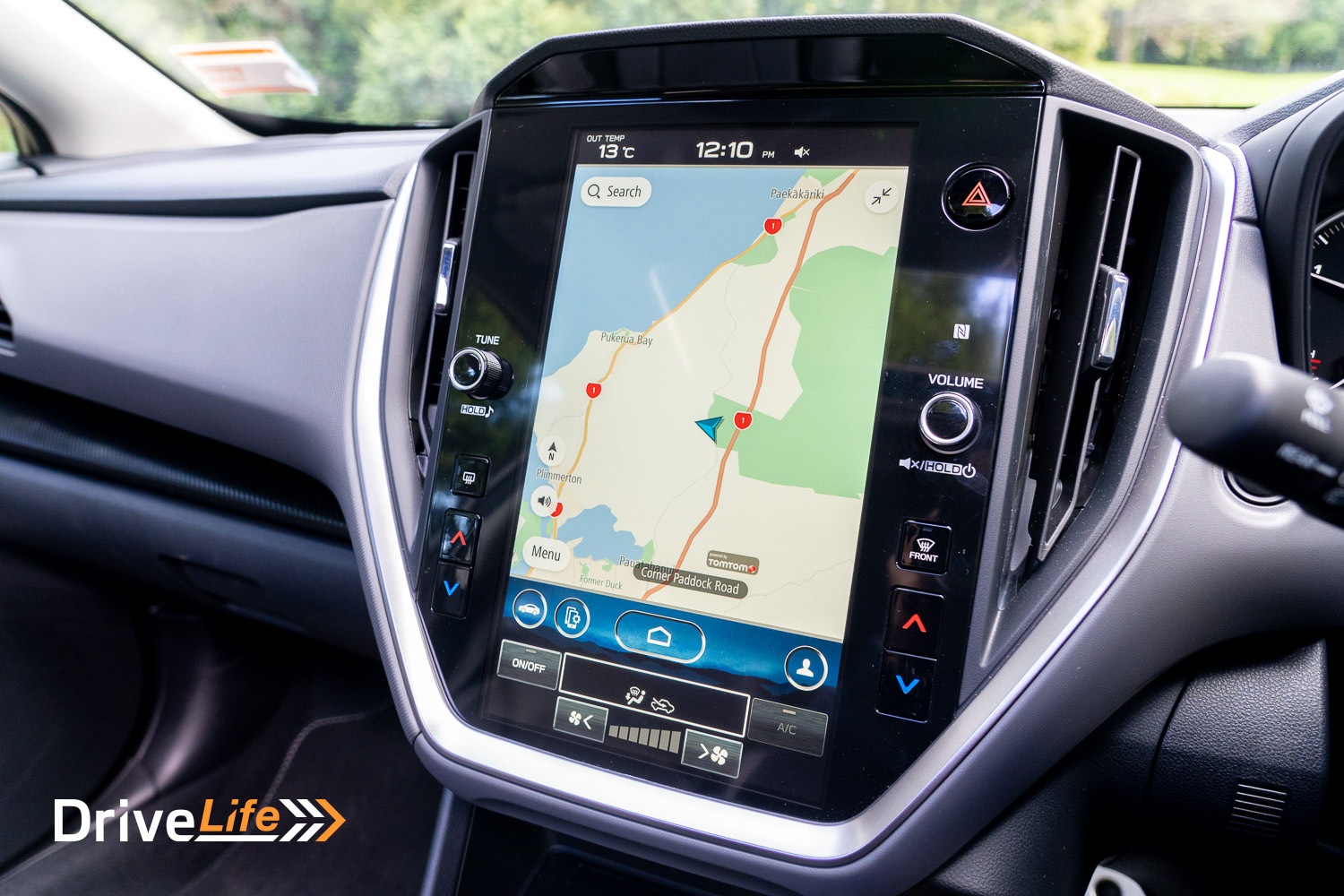
Down by the gear lever are the buttons for the front seat heaters. Again, these are physical rocker switches, although they do look like they are out of a 1990s parts bin. Not the end of the world, but they look extremely old school.
At the rear of the console is a huge cubby, easily big enough to fit an SLR camera. It’s huge for the size of the car. The glovebox is pretty decent in size too, especially after the half-size unit in the Skoda Enyaq I had just got out of.
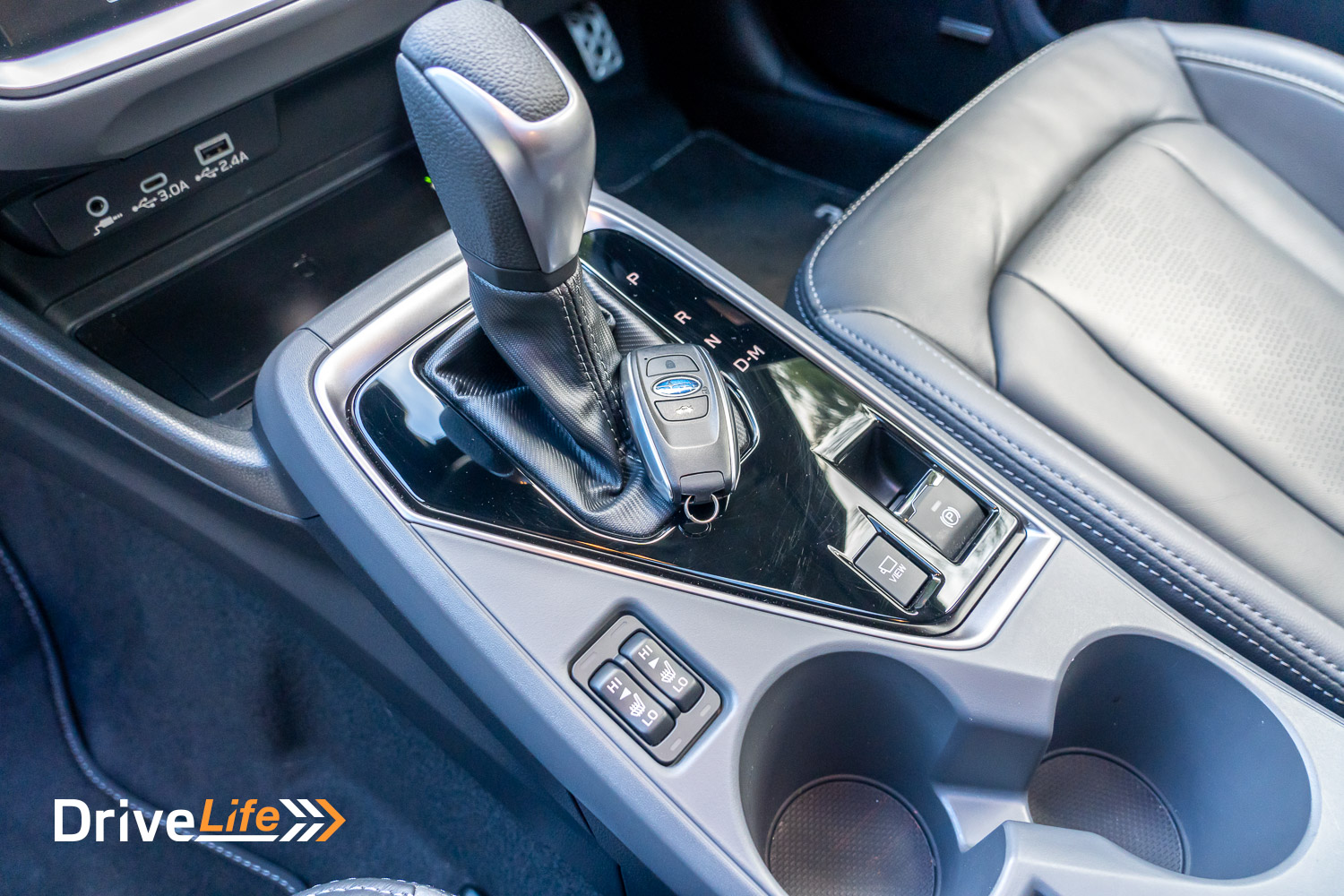
The front of the centre console carries both USB-C and USB-A ports, as well as an AUX port. There’s no 12-volt socket right up front, so I had to run my dashcam cable from the one that’s just in front of the console cubby. A first for Subaru, the Premium model has a Qi wireless charging pad; this is a flat plate at the front of the centre console. When I removed the cover, my phone ended up sliding around on the pad and stopped charging. The cover sorted this out, but something to keep in mind if you hate having a cover on your phone.
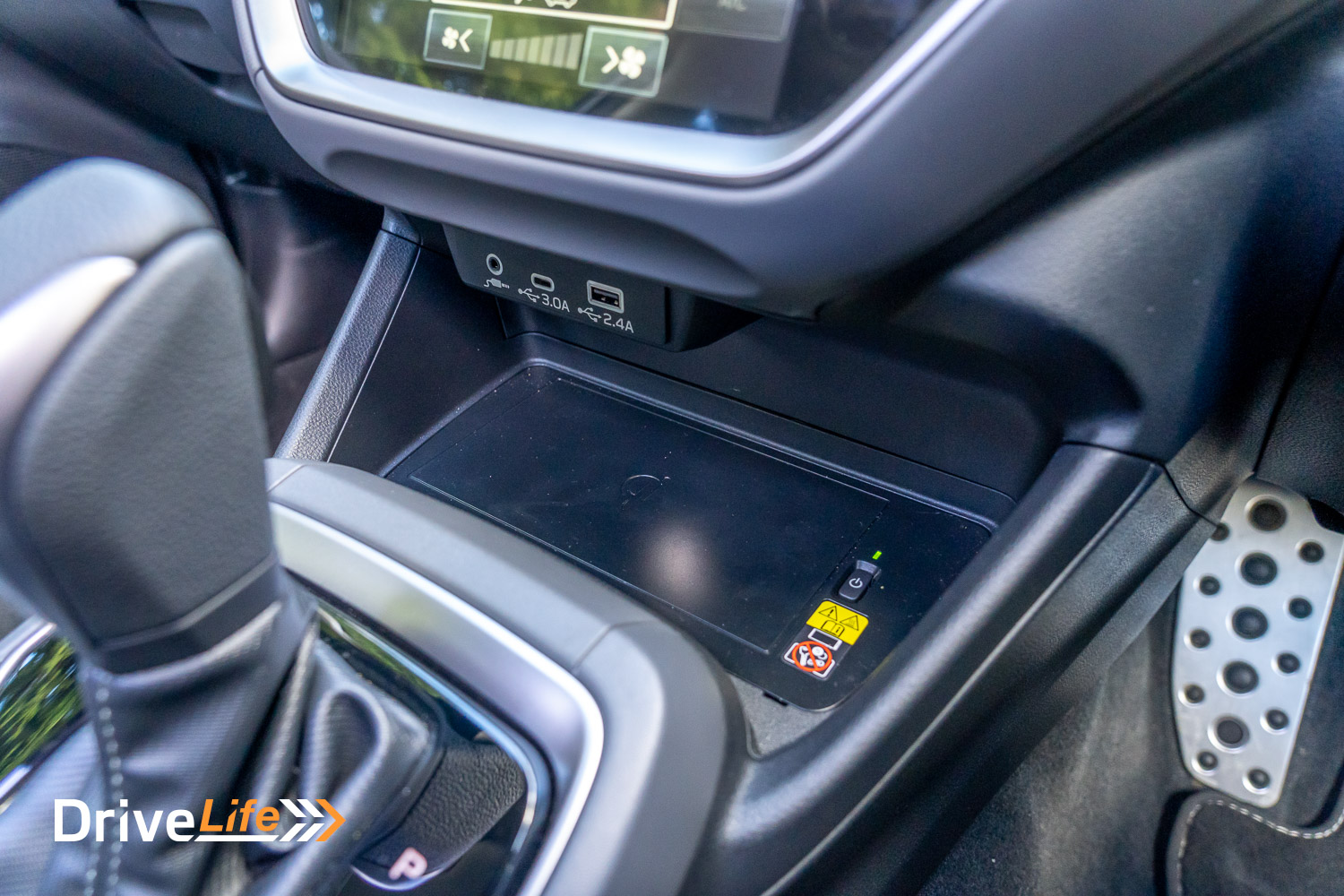
The driver gets alloy pedals in this model, giving the Crosstrek a sporty touch. Another sport-orientated touch is the fake carbon fibre across the dash and doors, but thankfully it doesn’t look too gaudy or out of place. There’s an excellent use of soft materials in the Crosstrek, and then practical plastic where it needs to be for this crossover SUV.
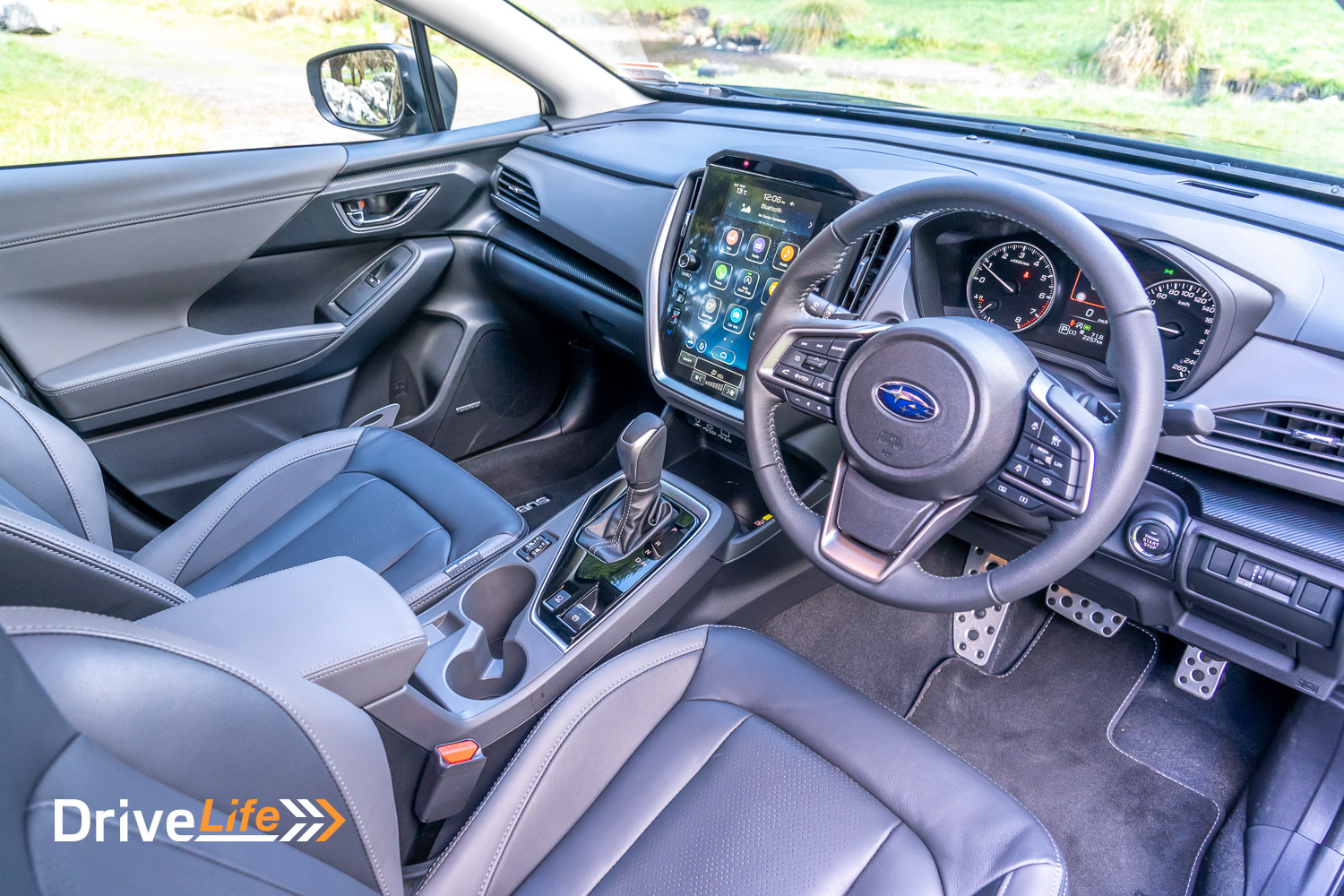
The interior of the Crosstrek can feel nice and airy in the front, aided by the beige headlining and pillars, and you can also open the (manual) blind on the tilt/slide electric sunroof to let in some more light. You don’t quite get that same feeling of openness in the back seat; the sloping roof and smaller side windows make it feel a bit closed in back there.
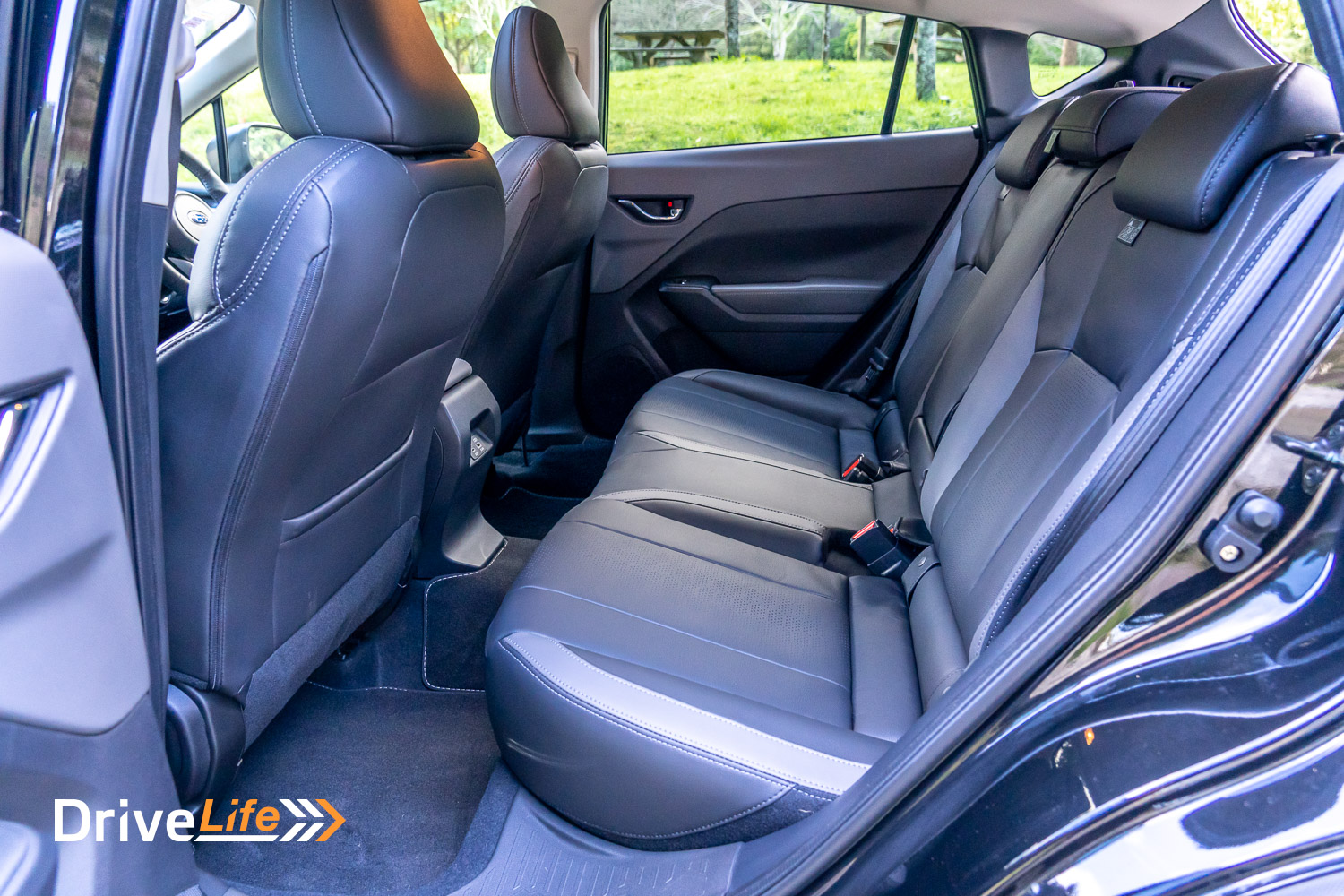
Rear-seat passengers do also get USB-A and USB-C ports, and there’s a reasonable amount of legroom room, although headroom with that sloping roof reduces a little.
The boot is on the small size at 291 litres, but under the floor is a welcome sight; a full-size steel spare wheel, true to Subaru who provides one with almost all their models but note if you buy the hybrid version of the Crosstrek, you don’t get a spare wheel.
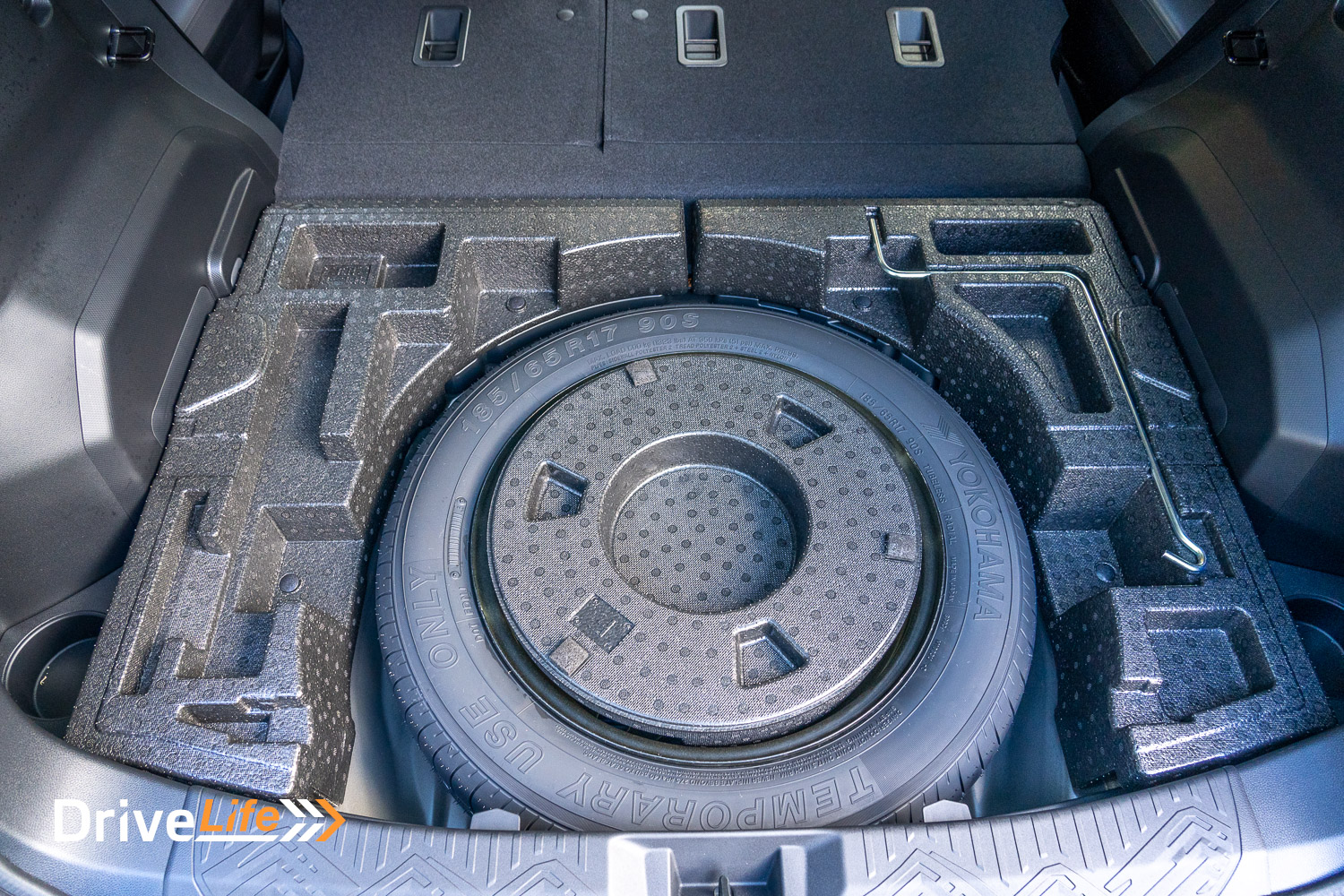
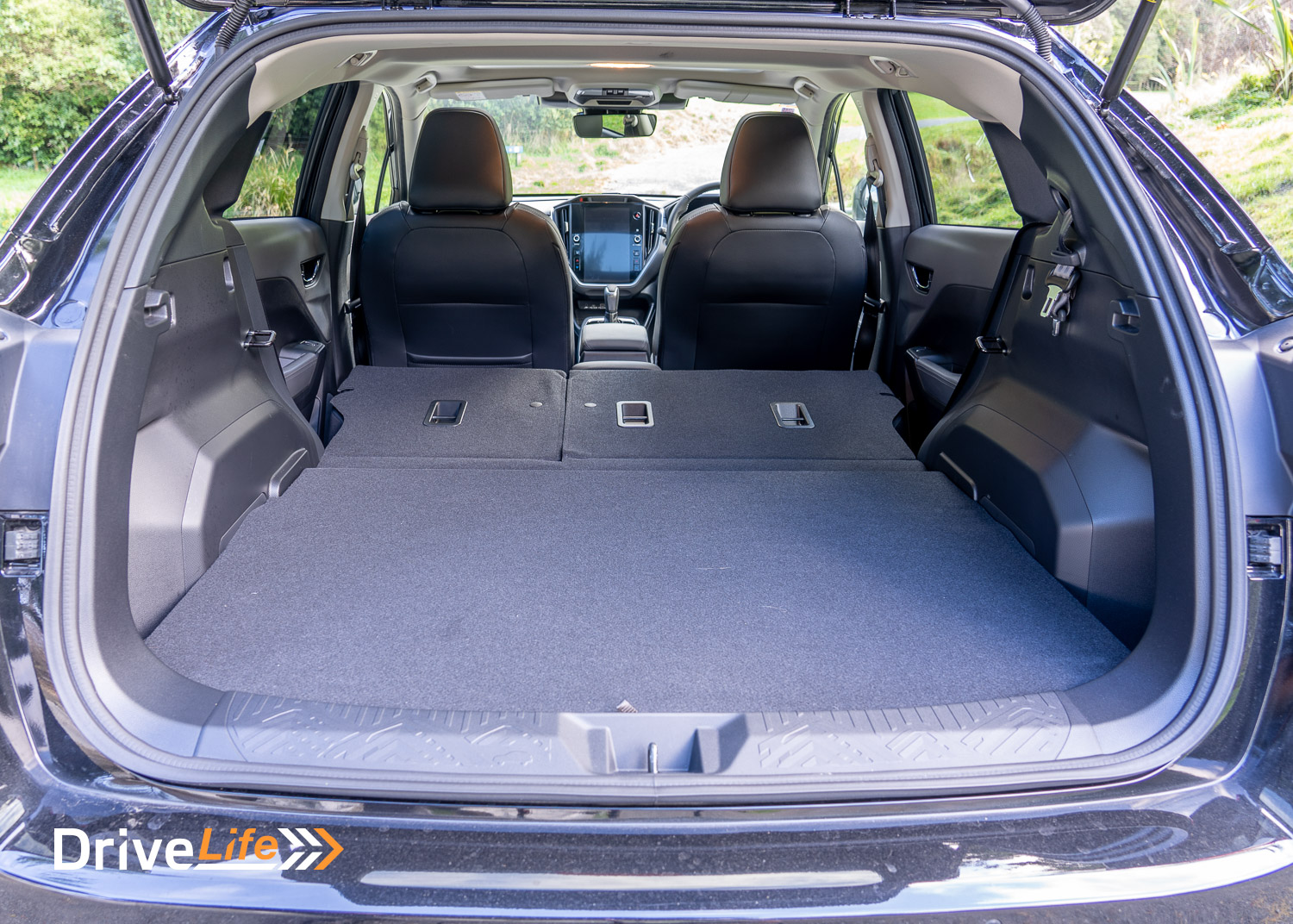
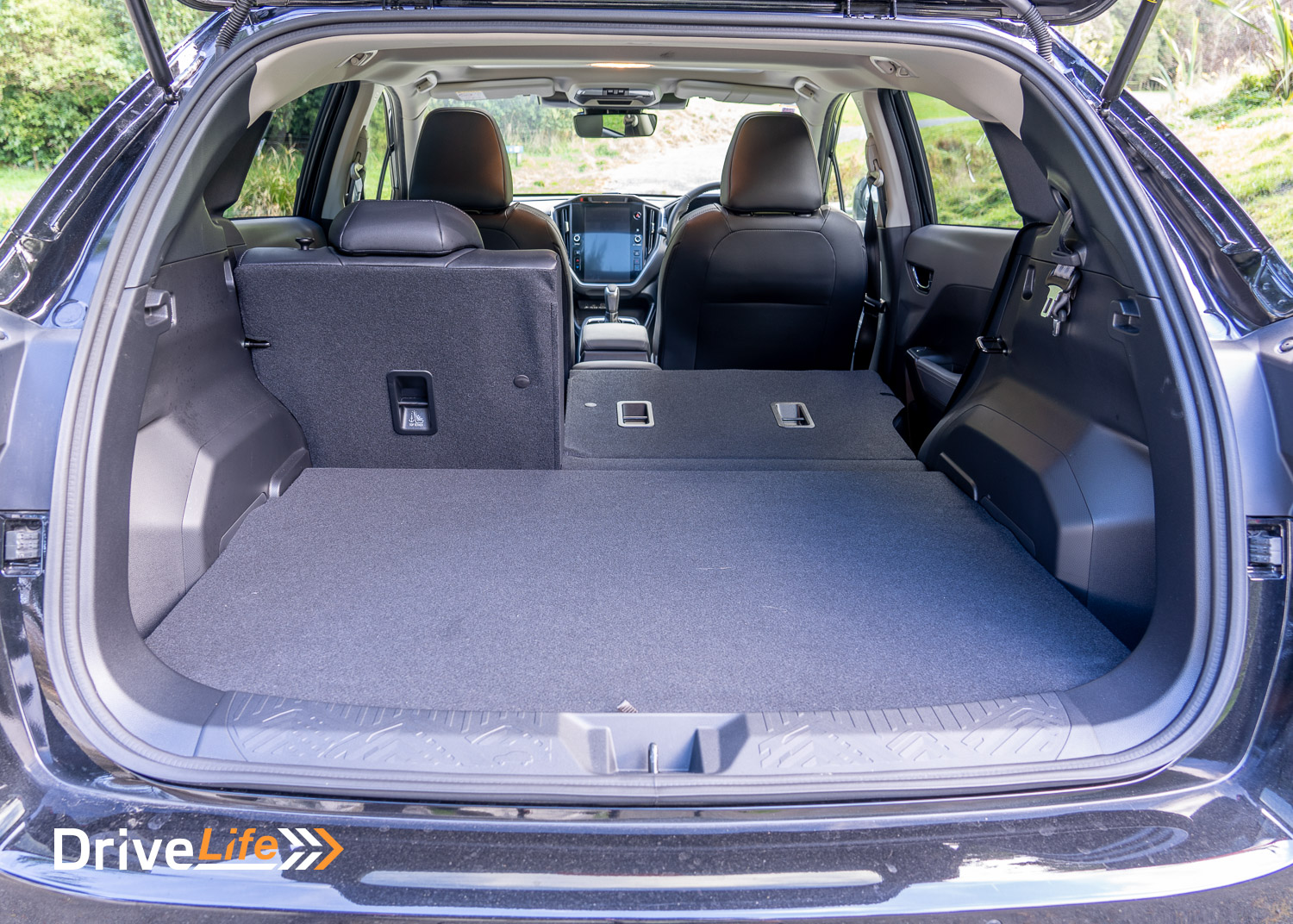
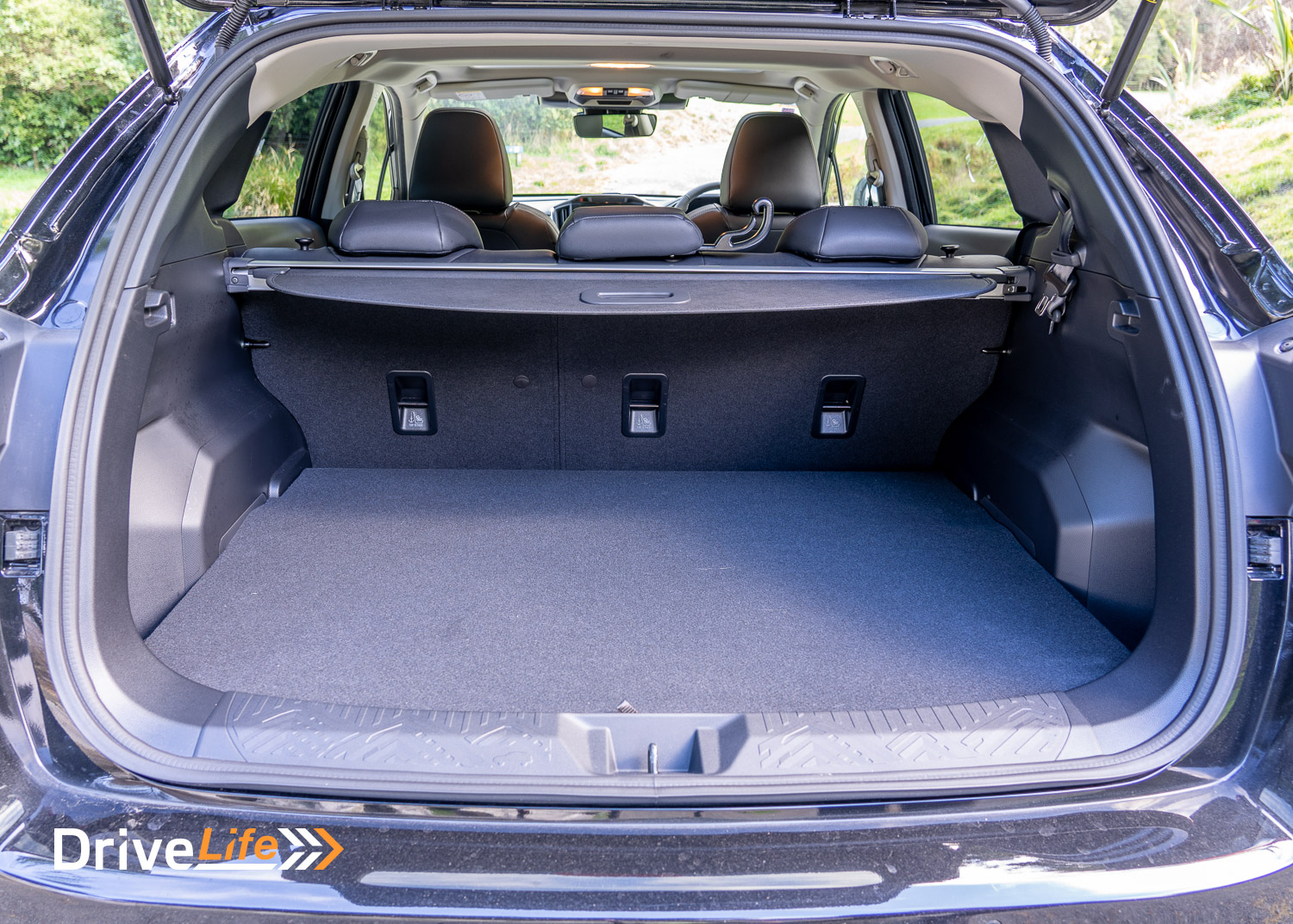
What’s The 2023 Subaru Crosstrek Premium Like To Drive?
It was great to see 650km of range showing on the Crosstrek when I picked it up. With a 600km return trip to Hawera to work on our project car later in the week and the price of petrol, fuel economy was going to be something I’d be watching with this car.
Out of the dealership, the brakes feel a bit grabby when cold, and the accelerator pedal is a bit touchy. I don’t recall this from the launch, so perhaps it was just our test car. Regardless, the Crosstrek feels like an XV in so many ways, as it should since it has the same engine and essentially the same chassis.
Heading home, visibility on the motorway is generally good, although that sloping roofline means smaller rear windows. But all Crosstrek models come with blind spot monitoring, so you have a backup system to help keep you safe.
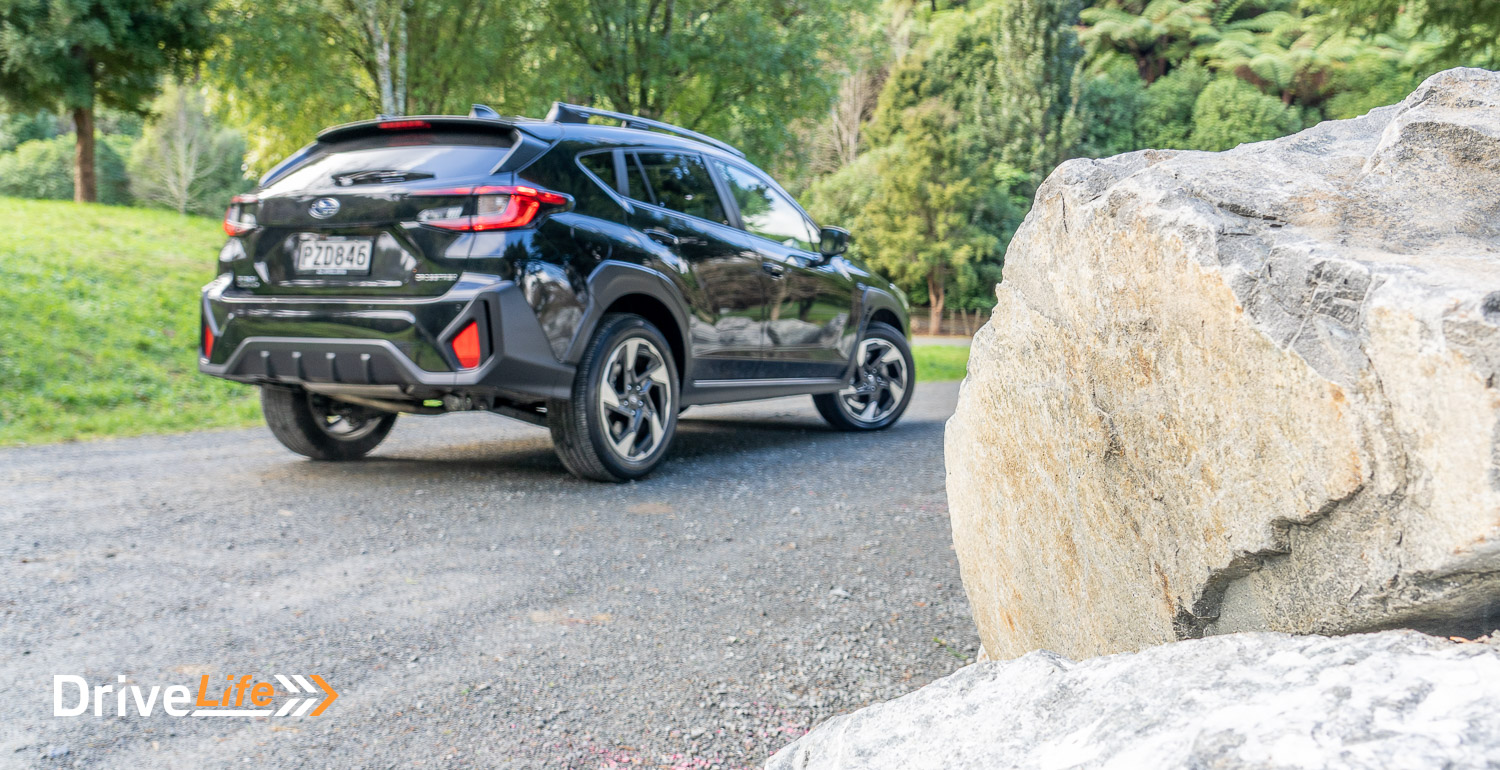
The Premium model has a 360-degree camera system and while the resolution isn’t fantastic, it’s still a very usable feature. You can hit the ‘View’ button on the centre console to cycle through 3 different views, each view giving you up to 3 views of the car on each screen, including bird’s eye. It’s brilliant for parking in a tight spot.
One of the benefits of the new model is that Subaru has taken on board our complaints of the adaptive cruise control beeping far too often, and this has been turned right off. Thank you, Subaru. The adaptive cruise used on the Crosstrek is an excellent one, with a smoothness that is not often seen without going to a high-end euro car. Interestingly, you do get some options around adaptive cruise control, so you can set it for Eco, Comfort, Standard, or Dynamic. There was little difference between each setting, but I basically left it in Standard and it did just fine.
While the cruise control beeping has gone, there is still a lot of other beeping going on, with every warning of some sort accompanied by a beep. Like other Subaru models, the Crosstrek has three LEDs under the windscreen that reflect up to help grab your attention. These are green for normal, orange for attention and red for urgent alerts. You get used to them very quickly and they are quite handy, so hopefully we’ll see a reduction of the other beeps at some point.
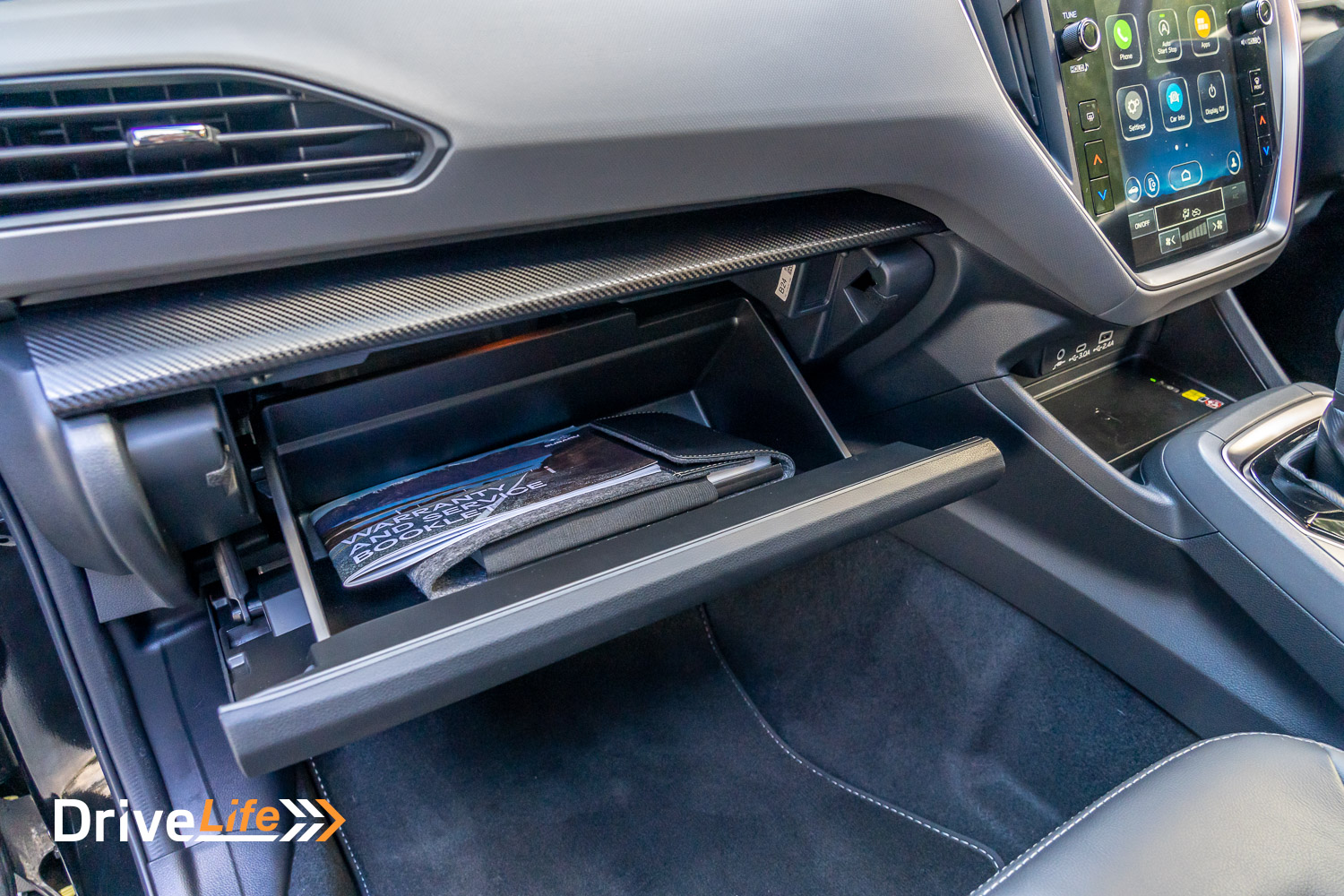
Some of those warnings are set off by the driver doing things they should not be doing, such as looking at a cellphone, not looking at the road etc. Subaru calls it their Driver Monitoring System, and it continues to be developed with each new model. This is mostly successful, and you will get alerts on the driver’s information display as well as the LEDs flashing. However, the system is not perfect. Just scratching your nose can set the system off, and at times just looking in the exterior mirror to check on traffic would get me a warning.
Along with adaptive cruise control, the Crosstrek also has a speed limiter. Nothing unusual there, as this is a common but underused feature of lots of cars. However, it was great to see that the Crosstrek’s speed limiter will also work downhill, slowing the car to the set speed. It won’t stop you crashing into the car in front, but it will hold the car’s speed. This is a rare but very handy change to the speed limiter system.
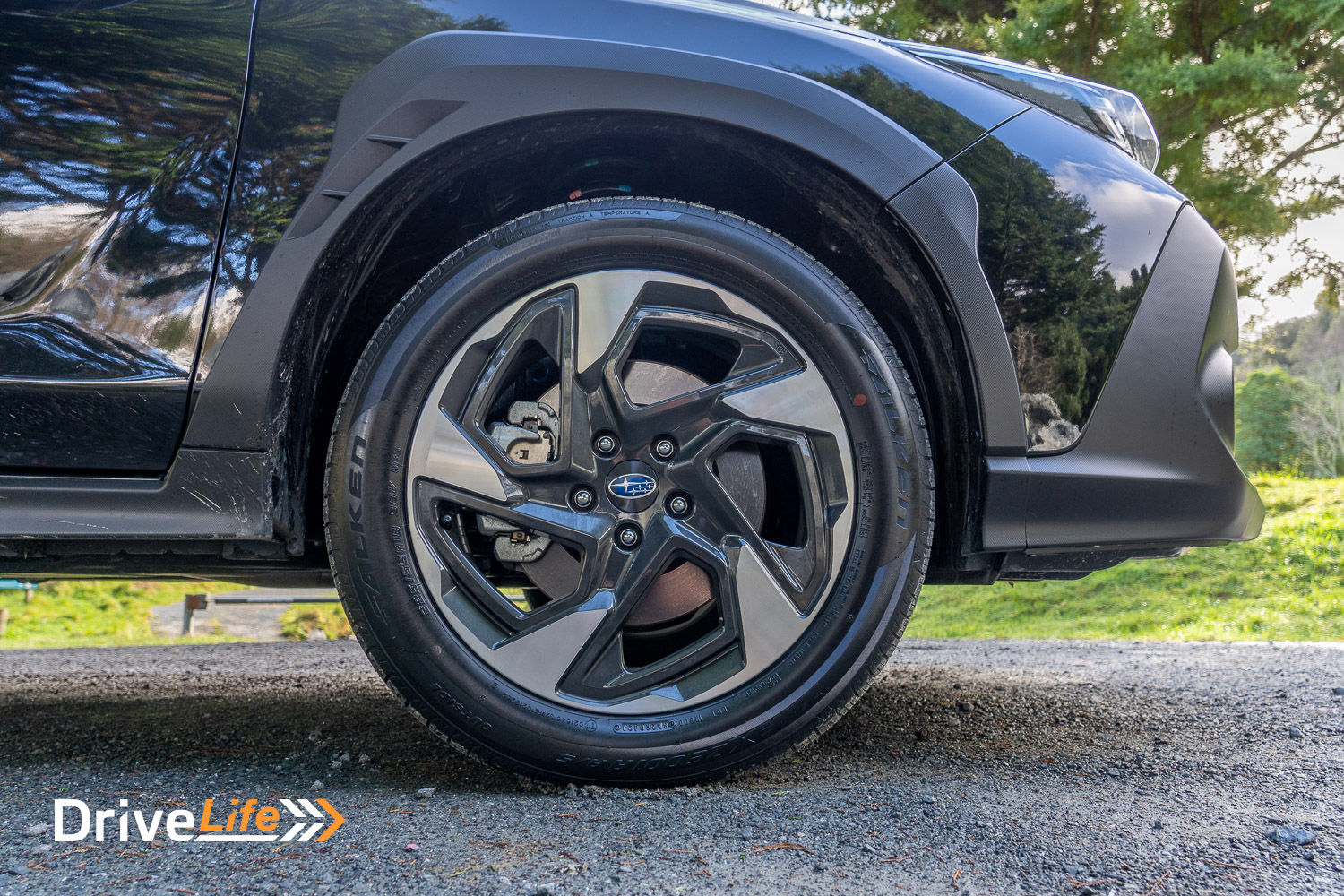
Another change in the speed limiter function is that it recognises speed limit changes and alters the speed limiter setting to the new speed, be that a higher or lower speed. This means you don’t miss a speed limit change, perhaps saving you from a speeding ticket. Weirdly, this functionality isn’t even an option for the Crossktrek’s adaptive cruise control.
That speed limiter functionality makes the Crosstrek easier to live with as a Daily Driver, and there were other aspects of the car that helped with this, making my two weeks with our test car a very enjoyable experience. As every day passed, I appreciated the Crosstrek more. Other things that help the car as a commuter or weekend runabout include the ride quality; on the launch, it felt good, but not great. Our test car had done over 2,000km when I picked it up, and it rode extremely well, so perhaps the Crosstrek needs a few miles under its belt to get the best ride quality.
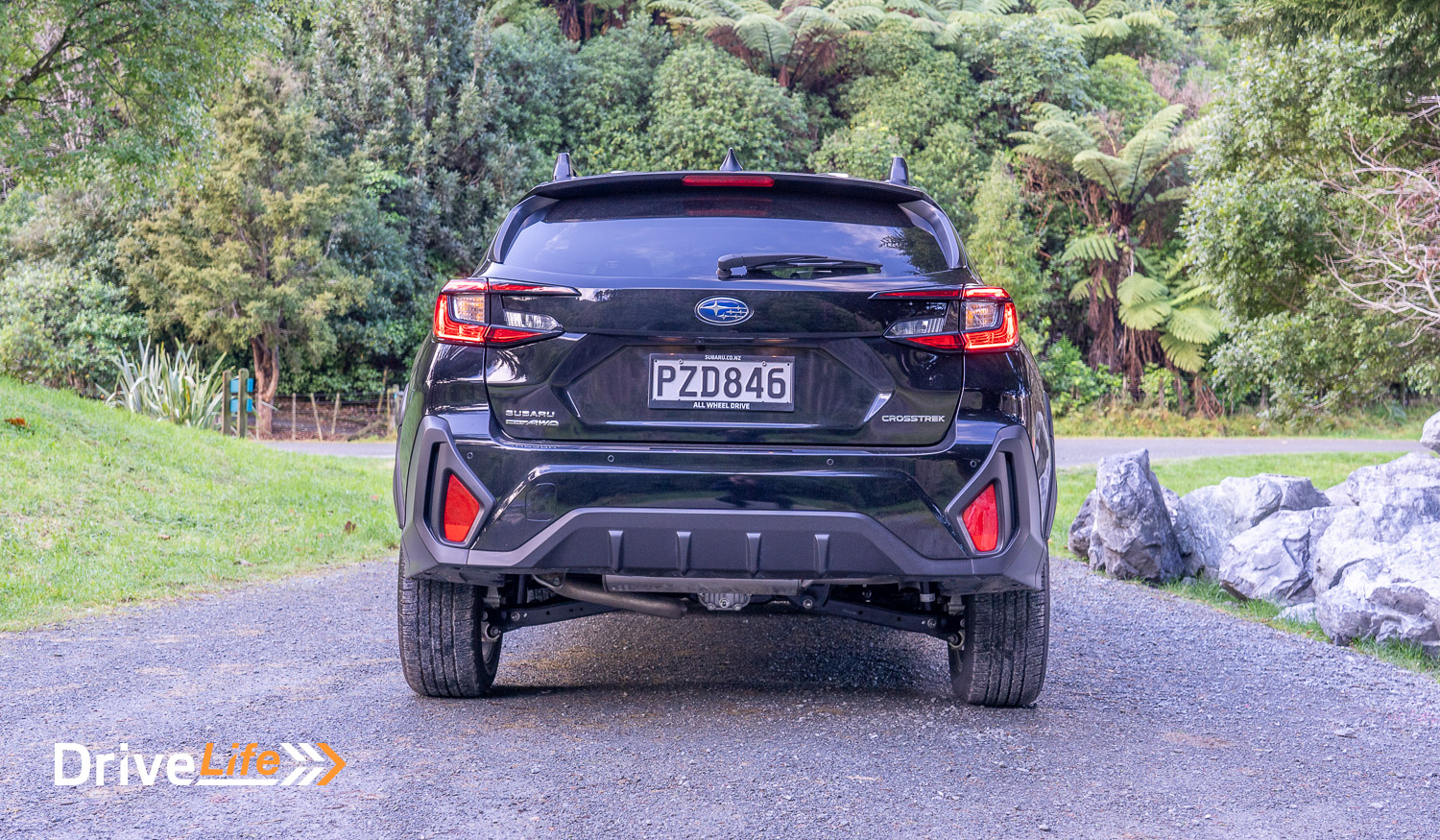
That supple ride also means the car is not upset by bumpy corners in the slightest. Add into this Subaru’s Symmeritrcal All-Wheel-Drive, and you have a car that’s a pretty safe drive. If you try and rally drive it a little you will notice lots of body roll and understeer, but overall and in most normal driving conditions, you are in safe hands with the Subaru Crosstrek.
Since we tested the Crossrek in the middle of winter, that meant lots of driving in the dark. The Crosstrek Premium has directional headlights like we last saw in the Subaru Outback XT. These are superb lights, turning to aim toward any corners coming up. Aiding the headlights are cornering lights; the Crosstrek uses LED cornering lamps to help light up the corners. It all adds to safety and driveability in all conditions.
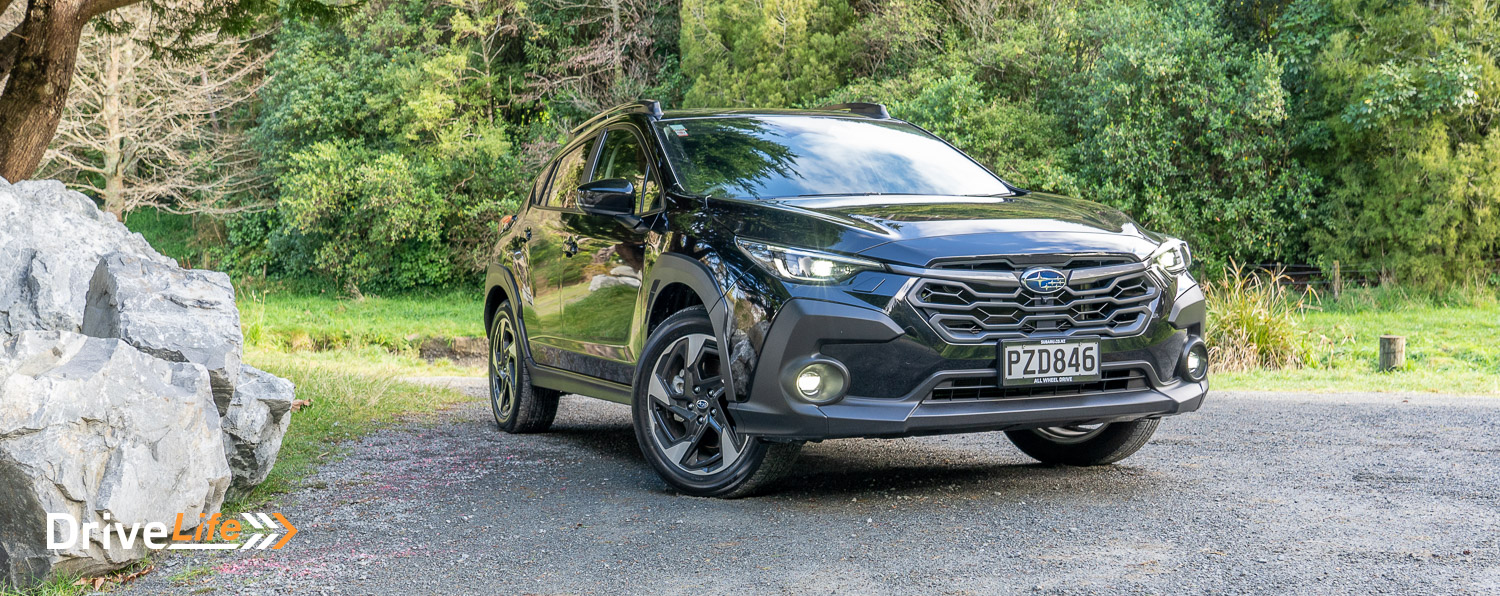
At the end of the first week with the Crosstrek, I headed off on the 300km drive to Hawera to work on our project car. This long and boring drive gave me a chance to observe some of the Crosstrek’s good and not-so-good points. The steering wheel is suggested as being leather-wrapped, but it feels like plastic. The engine performs adequately but can get noisy above 5,000rpm. The thing is, you need to wind it out to pass other cars safely but taking it above 5,000 feels a bit like torture. The Crosstrek – like other Subarus – has two drive modes; Intelligent (default) and Sport. Switching the car into Sport will give you peppier performance and sometimes that’s needed. With 115kW of power and 1,532kg of weight, you’re going to need Sport mode now and then, likely more when the car is really loaded up.
A minor gripe is around the steering wheel controls. With 12 buttons controlling 18 functions, the design and layout of the buttons need to be top-notch to stop the driver from having to look down. But look down, I did. One of the main issues I found (and it’s likely more a personal choice than an issue) is that on the left side of the wheel, there is an up/down toggle which you would assume is for controlling the audio volume. But it’s not – that toggle changes the driver’s information display screens around, while a left/right button at the bottom of the wheel does volume. I generally find that once I select my favourite screen to view on the dash, I leave it there. How I wish that toggle was for the volume up/down. Again, more a personal choice than a problem.
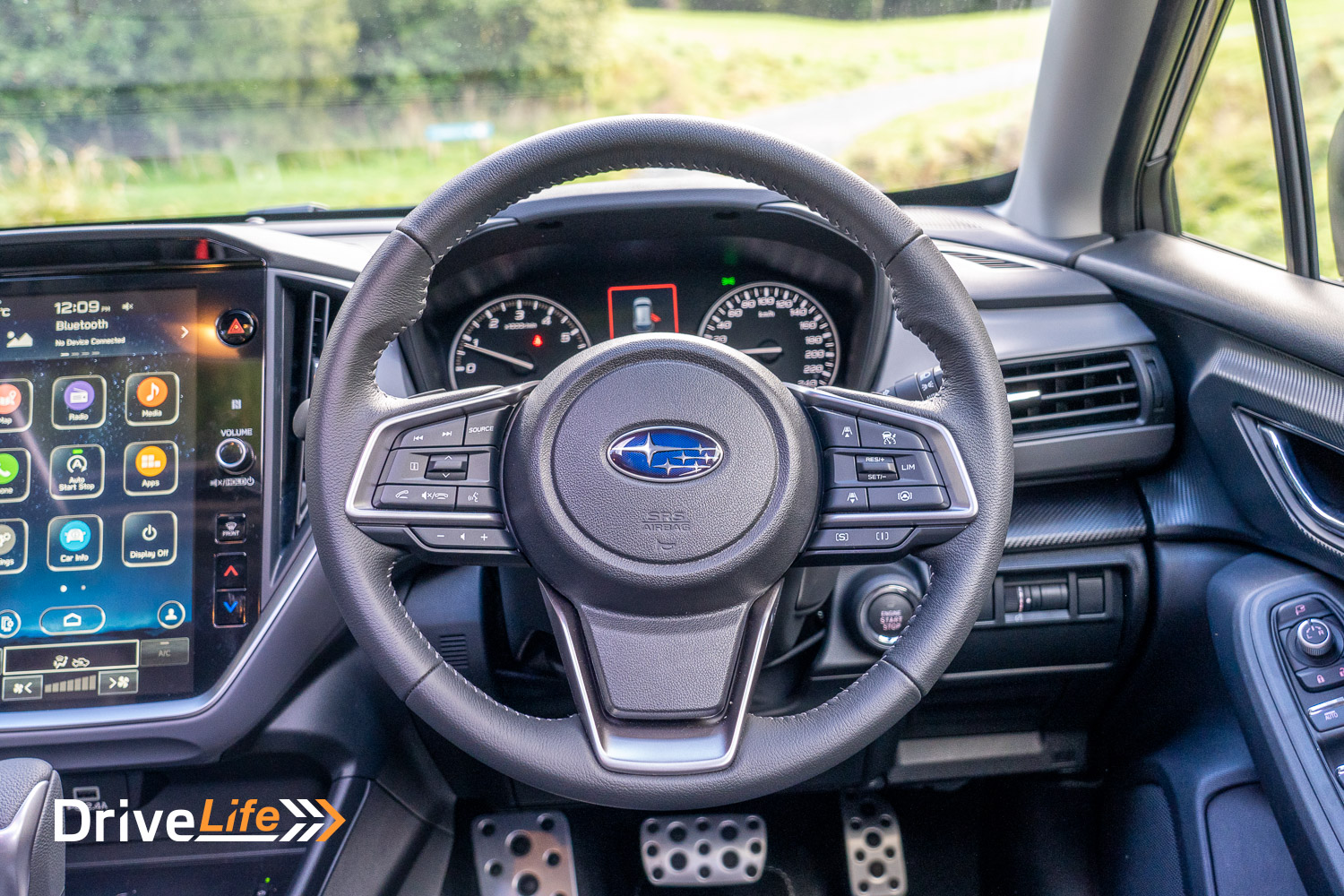
On the positive side of the ledger, the constantly variable transmission (CVT) is an improvement over the XV. It’s still a CVT, but just tottering around town is fine. The CVT has Subaru’s 8-speed stepped transmission function, so it can feel like a ‘normal’ automatic. Past iterations of this idea in Subarus have had mixed results but with the Crosstrek, Subaru have done well. Accelerating hard will see the car use a stepped mode, and it feels good.
We were told at the launch, that Subaru took a “human-centred design approach” for the interior and this means redesigned front seats, with the seat rails now mounted directly to the chassis to reduce head sway on bumpy roads. After doing so many hundreds of kilometres in the Crosstrek, the seats are excellent. An almost straight 300km drive saw no aches or pains, and good support on all sides. Top marks, Subaru.
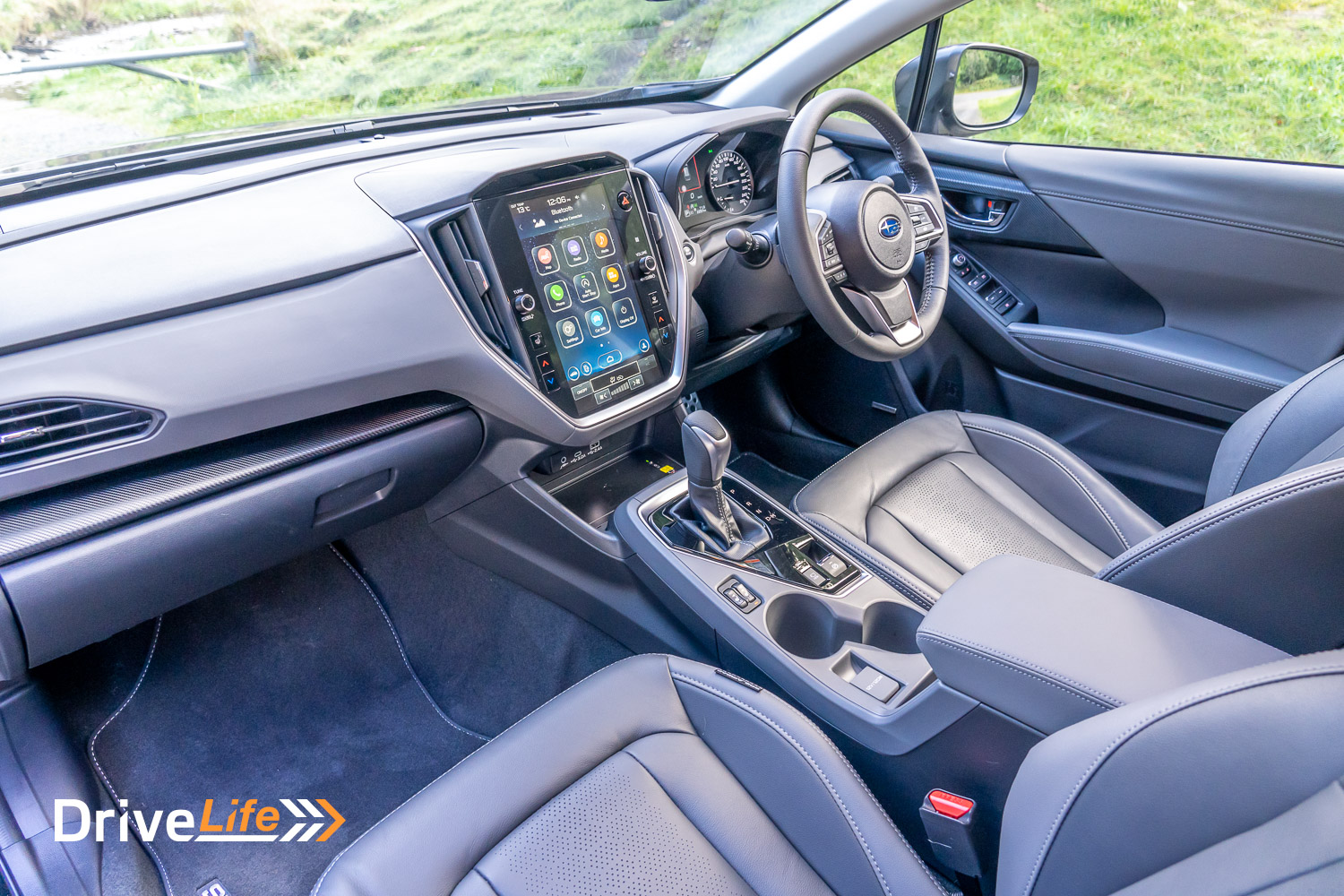
And then on the trip north, it poured down. I could visibly see other cars struggling to keep straight in their lane, while the Crosstrek and I simply soldiered on with absolutely no drama. It was one of those times I was sold on all-wheel drive.
The Crosstrek has simple analogue dials all clearly laid out and crisp and clear, although there is no 50km/h marking and the digital speedo is a little small.
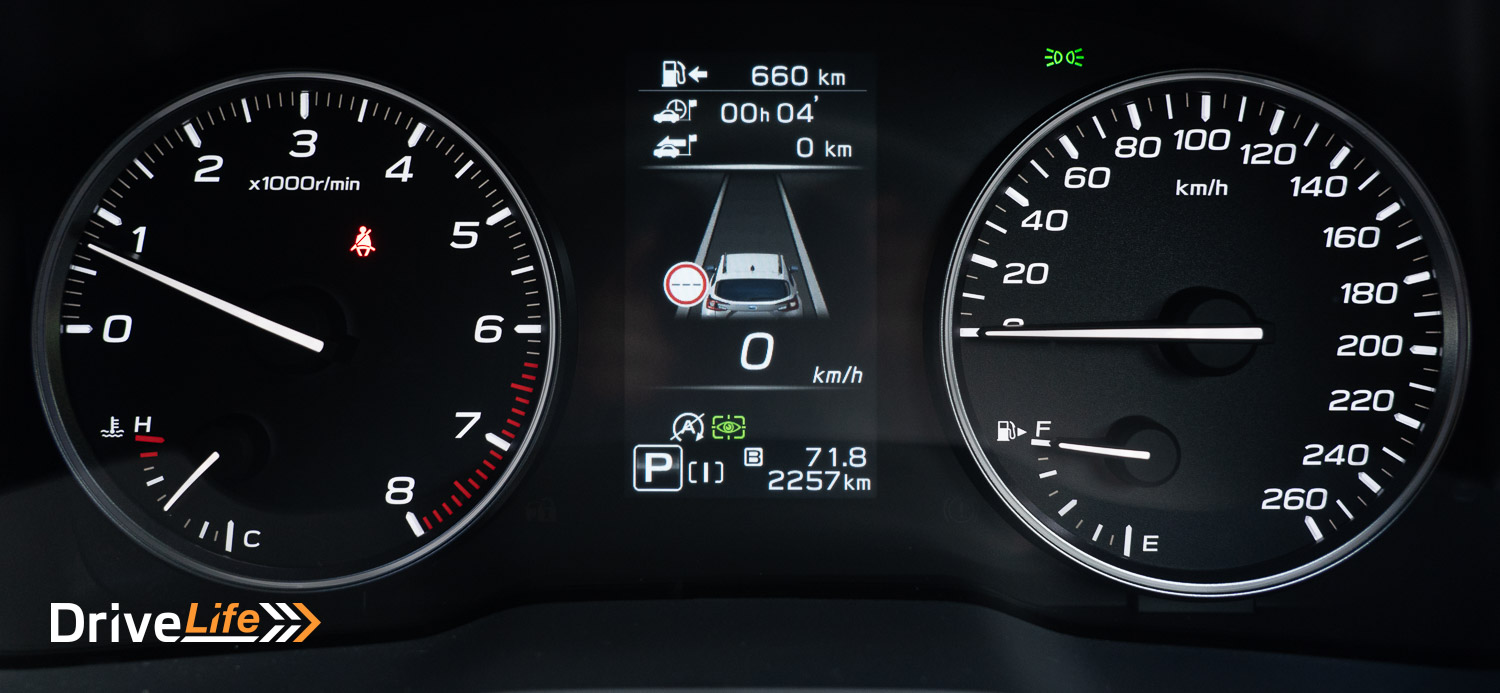
On the way to Hawera, I had to stop for my first lot of fuel since picking the car up. I had driven 710km, and had 60km left in the tank for a range of 770km – that’s excellent. Fuel economy to this point was 7.5L/100km, not bad for a 2.0-litre motor. Since the Crosstrek is not turbocharged, it will take 91 octane fuel, so a cheaper fill than many other cars. A nice touch with low fuel in the Crosstrek is that the centre screen will pop up to tell you that you are low on fuel, and would you like to search for a gas station. Once you select one, SatNav takes over and directs you there.
One of the new features in the Crosstrek that the XV does not have is Lane Centering. This does an admirable job of holding the car within its lane, although it does seem to favour the centre line too much. At times I felt I was fighting the car to keep it in the middle or to the left of the lane, so turned it off. We’re seeing this occurring in other brands as well, so hopefully it gets sorted soon.
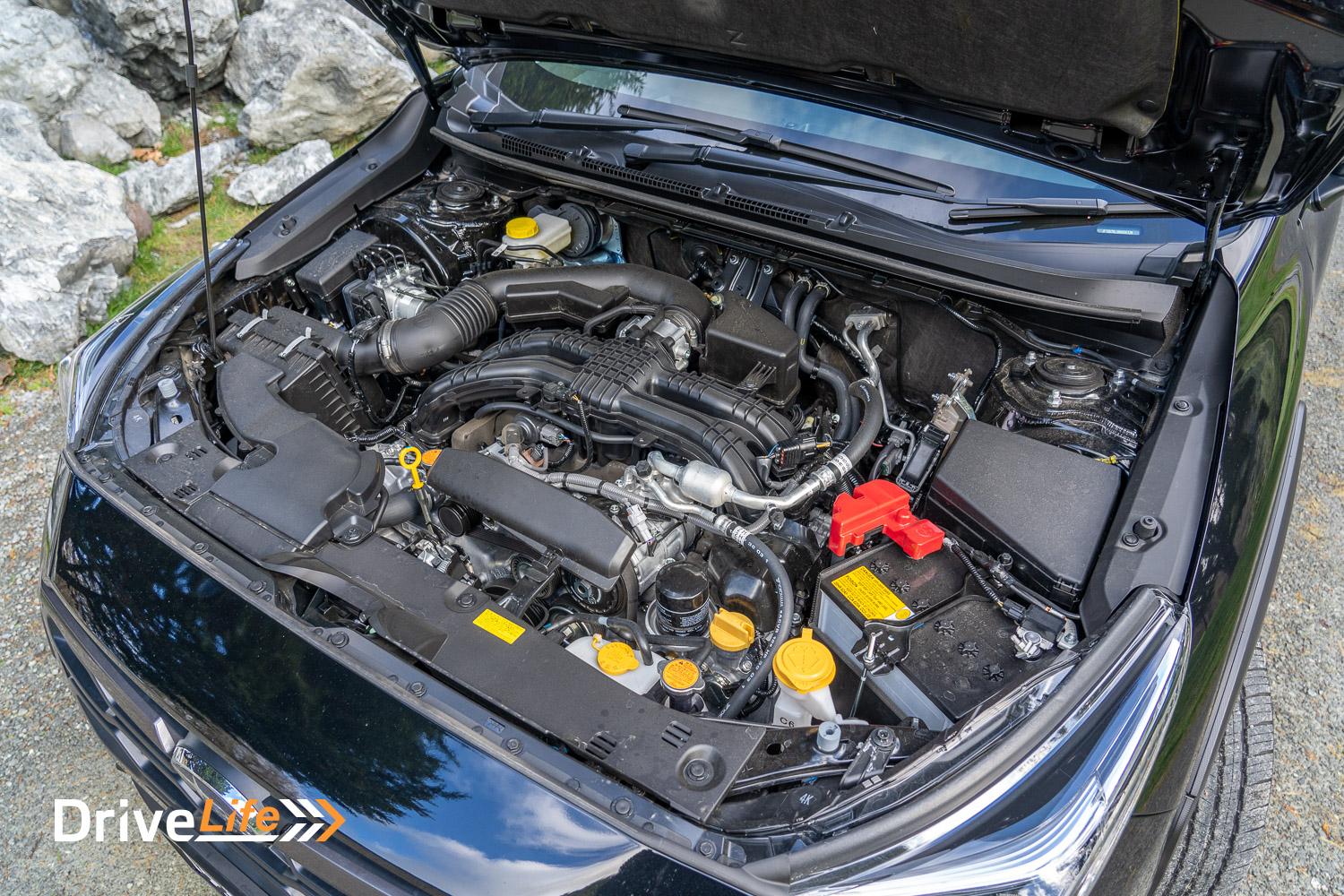
Part of Subaru’s symmetrical all-wheel drive system is X-Mode; Like other Subaru models, this gives you some options if you decide to head off-road. Those X-modes are:
- Normal
- Snow/Dirt
- Deep snow/Mud
Keep in mind to change your X-mode you will need to stop the car, and instead of using a knob or button to change the modes, you’ll find it at the top of the infotainment screen. That all-wheel drive and X-modes are paired up with 220mm of ground clearance, the same as the XV. This does mean the Crosstrek should be just as capable in off-road conditions as the XV.
I wasn’t expecting fuel economy to be much better than the 7.8l/100km I got out of the last XV I tested, back in 2020. Surprisingly, after 1,500km of mixed driving our Crosstrek test car managed to do 7.6L/100km. That’s not too bad for a 2.0-litre non-hybrid and compares well to the 7.2L/100km that the Crosstrek is supposed to return.
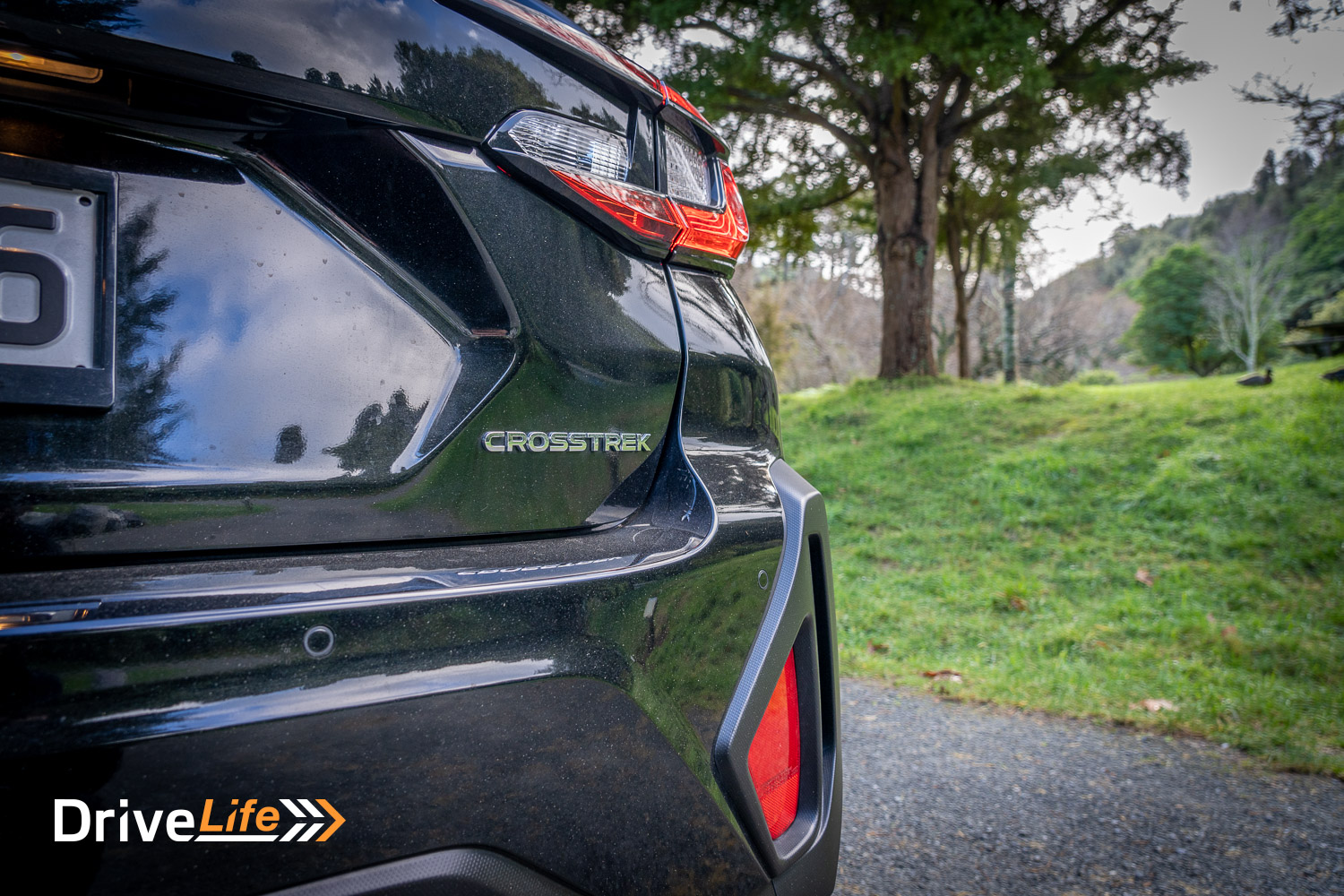
2023 Subaru Crosstrek Premium – Specifications
| Vehicle Type | Small/Medium Crossover SUV |
| Starting Price | $48,990 |
| Price as Tested | $48,990 |
| Engine | 2.0-litre, horizontally-opposed 4-cylinder petrol |
| Power, Torque kW/Nm | 115@6,000rpm 196@4,000rpm |
| Transmission | Constantly Variable Transmission with 8-speed stepped mode |
| Spare Wheel | Full-size steel |
| Kerb Weight, Kg | 1,493 |
| Length x Width x Height mm | 4495x1800x1600 |
| Boot Space / Cargo Capacity, Litres (seats up/seats down) | 291/1,261 |
| Fuel tank capacity, litres | 63 |
| Fuel Economy, L/100km | Advertised Spec – Combined – 7.2 Real-World Test – Combined – 7.6 Low Usage: 0-6 / Medium Usage 6-12 / High Usage 12+ |
| Towing Capacity Kg, unbraked/braked | 650/1,400 |
| Turning circle metres | 10.8 Small: 6-10m / Medium 10-12m / Large 12m+ |
| Warranty | 3 years, 100,000km |
| Safety information | ANCAP Rating – 5 stars – Link (XV rating only at the moment) Rightcar.govt.nz – 5 Stars – PZD846 |
Have you enjoyed this review? Be sure to join our monthly email newsletter list so you don’t miss a single car review!


